Loch Ness, Scotland
Written by Rick Archer
Published October 2013
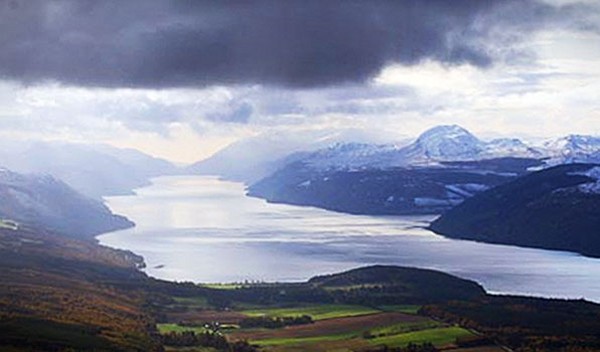
|
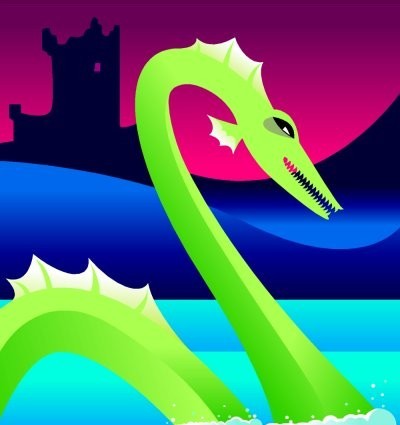 |
THE
STORY OF THE
LOCH NESS MONSTER
|
Forward
Rick Archer's Note:
This article takes a look at the enduring Loch Ness
mystery. I became intrigued with the story
when Marla and I visited Loch Ness on
our Oslo 2010 cruise.
I soon learned that Loch
Ness has an odd shape. It is 22 miles long and one
mile wide. I also learned that "Loch" is
Scottish for 'lake'. So I have a question for
you. Six of the names below are well-known lakes in Scotland, but one is made up.
Which one of the following lake names listed
below is a fake name?
-
Loch Lomond
-
Loch Oich
-
Loch
Glen
-
Loch Morar
-
Loch Lochy
-
Loch Dochfour
-
Loch Linnhe
Now before I
answer the question, I have another question for the
Reader. Have you ever heard of any of these
lakes?
|
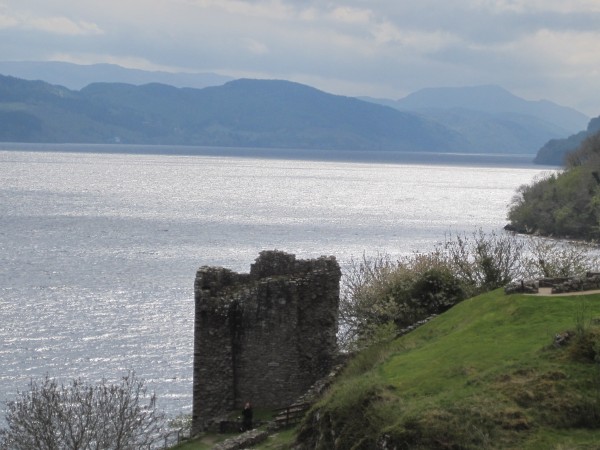 |
Perhaps you
have heard of Loch Lomond. After all, it is
the largest lake in Scotland. But more likely
you have never heard of any of them. In fact,
I am sure the Reader will readily admit the only
lake in Scotland you have ever heard of is
Loch Ness. And we all know why that
is.
Nessie is worth
a small fortune to the Scottish tourism industry.
Specifically, it is of great value to the economies
of Inverness (Gaelic for "mouth of the river
Ness") and the Highlands.
In fact, one can argue the legend of the Loch Ness
Monster is by far the most profitable 'rumor' in
recorded
history. For example, why on earth would our
cruise ship stop near this obscure place
otherwise?
Although Loch
Ness is the second largest Scottish lake by surface
area after Loch Lomond, due to its great depth, Loch
Ness is the largest lake by volume. Having
seen it, I can attest Loch Ness is
a vast lake indeed. My pictures of the lake
cannot begin to do justice to its immense size.
On the other
hand, compare Loch Ness and its surface area of
22 square miles to Lake Erie and its 9,910 square miles.
Mind you, Erie is the smallest Great Lake. In
other words, Loch Ness is big, but it isn't that big.
By the way,
"Loch Glen" is the fake name. Did you guess
it? Hey, cheer up. I would not have gotten it
right either. I am simply making the point
that without the monster, no one outside of
Glasgow or Edinburgh would have ever heard of
Loch Ness. The monster is responsible for its
fame.
|
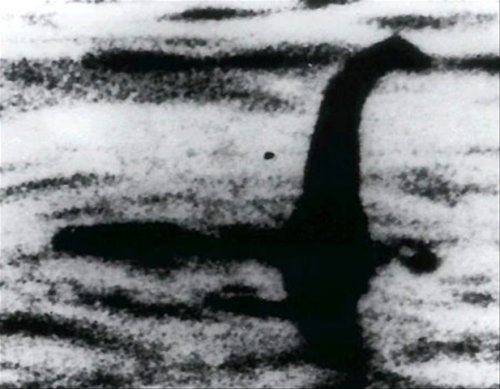
The famous 1934 picture that started all the fuss
|
Four
of the lakes listed - Loch Lochy, Loch
Oich,
Loch Dochfour,
Loch Ness
- are part of the Great Glen. The Great Glen is
series of rivers and lakes that follow a large geological fault
line known as the Great Glen Fault.
Basically the Great
Glen is an enormous gash in the earth that splits the Scottish
Highlands into two parts. The Great Glen forms a chain of
rivers, canals and lakes that connect the North Sea all the way to the Atlantic
Ocean. This long waterway is known as the Caledonian
Canal.
Take a look at the map and try to guess how
long the canal is. I bet you will be surprised at the answer.
I know I was.
Completed in 1822, the
Canal bisects
the Scottish Highlands into the Grampian Mountains to the
southeast and the Northwest Highlands to the northwest.
This giant gash in the earth is so deep that it divides Scotland in
two. In a way, the entire area known as the Northwest Highlands is
an "island" of sorts.
The Glen is a natural
travelling route in the Highlands of Scotland, which is used by both
the Caledonian Canal and the shoreline road A82.
Both arteries link the city of Inverness on the northeast coast with
Fort William on the west coast.
So
how long is canal? 60
miles.
The four lochs comprise
40 of the 60 mile length. Then there are 20 miles of man-made canals
that connect the lakes. However, if you add
Loch Linnhe just south of Fort William, then the distance
becomes
closer to 90 miles. And when you add in the large Moray
Firth at Inverness, the combined total reaches 130 miles.
|
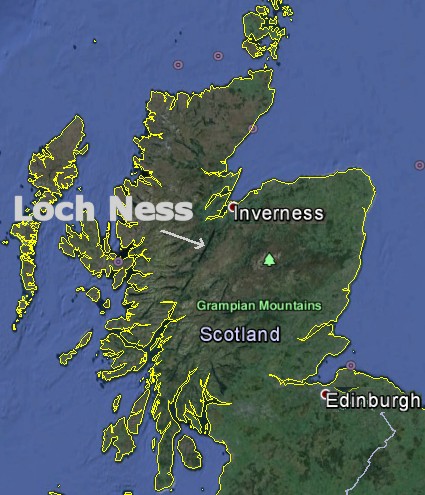 |
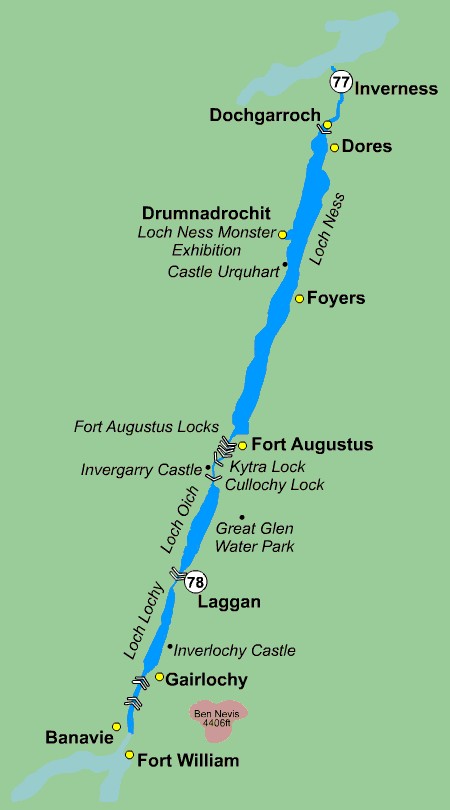 |
|
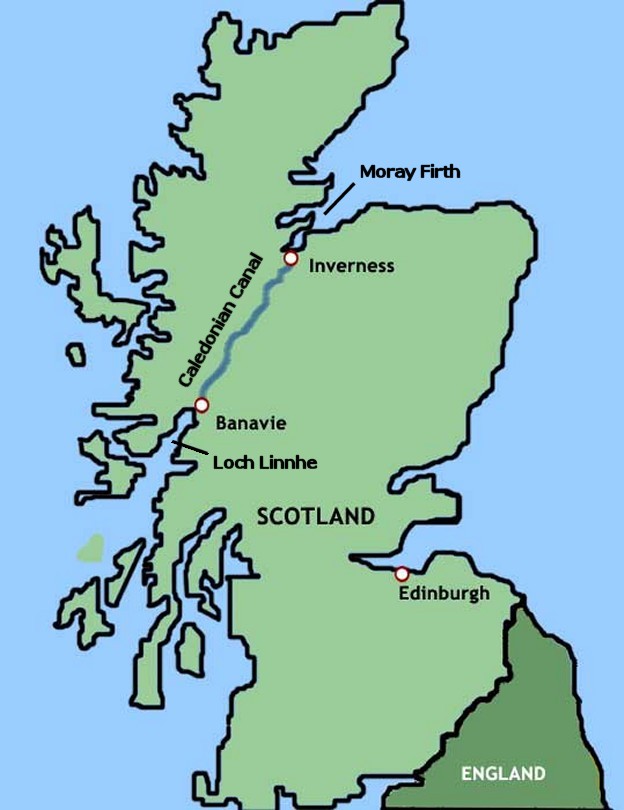 |
Are there river cruises
on the Caledonian Canal? The answer is yes. Since the canal
cuts completely through Scotland’s interior, a boat can cross the
entire nation by water (hint - this makes for an excellent trivia
question).
Stretching from
Inverness to Fort William, this unique waterway offers
visitors an unending path of spectacular scenery. There are
riverboats that take tourists on a fascinating voyage through the
legendary lochs and the giant mountains looming above complete with
castles and moors.
I knew you were going to
ask - The answer is "yes, there are locks on the lochs".
In addition to the 4 lochs, there are 29 locks, 4 aqueducts and 10
bridges in the course of the canal. In a manner similar to the
Panama Canal, there are locks at both end. There are eight locks at
Neptune's Staircase in Banavie and Dochgarroch Lock near Inverness
at the other end.
|
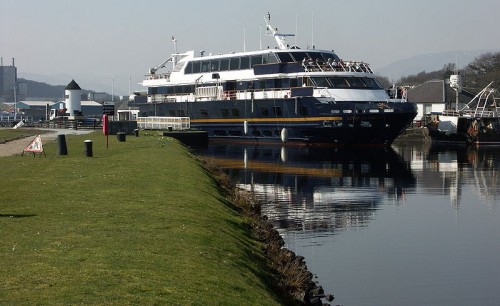 |
 |
|
|
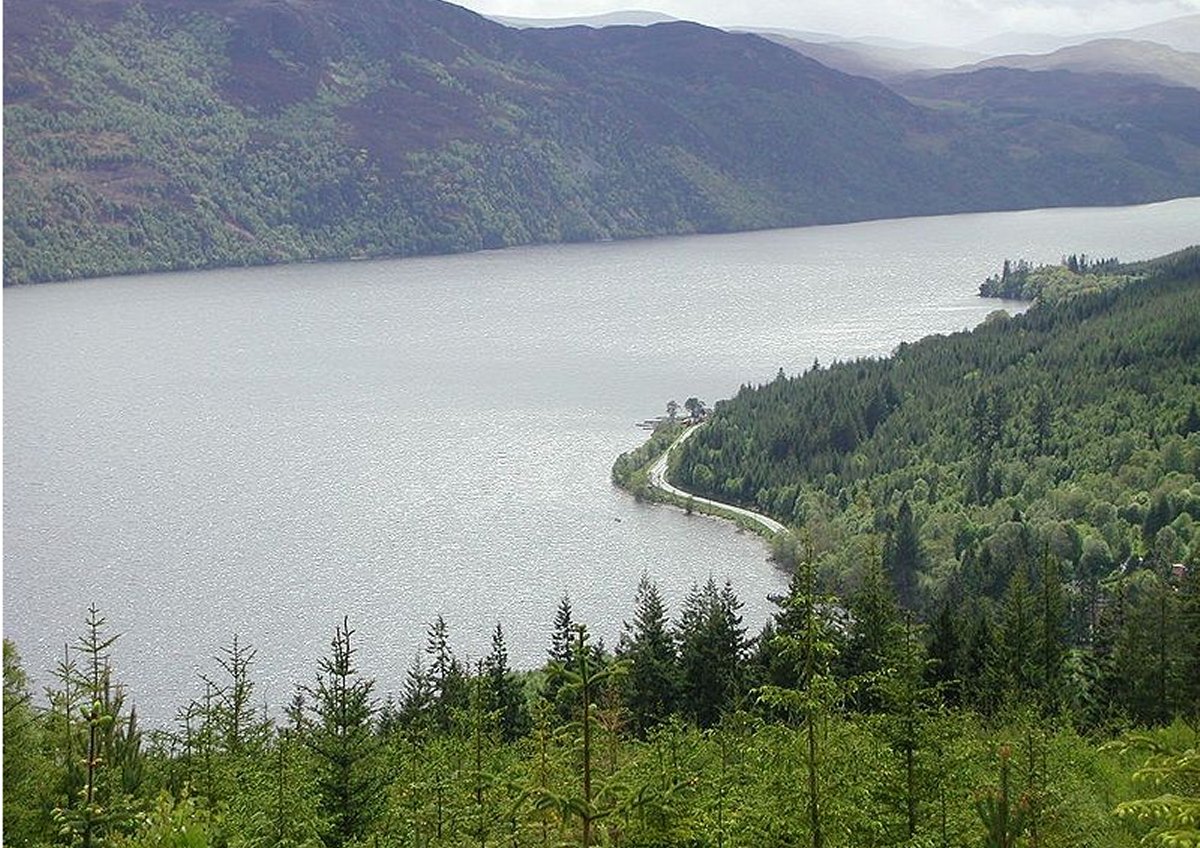
The
Cold Hard Facts about the Loch Ness Monster
|
To many, the
unusual depth of the lake lends credence to the
theory that maybe a monster might indeed exist down
there. Surely in this vast body of water a
giant sea serpent could find a subterranean lair to hide in.
Most scientists
do not agree. Few scientists believe such a creature like Nessie could
plausibly exist. They think the chances of a monster
surviving in these sub-zero waters are as likely as the
existence of Santa
Claus.
For example, if Nessie was a plesiosaur or some
other Mesozoic marine reptile as some suggest, she
would need to surface frequently for air. Loch Ness may
be one of the largest freshwater bodies in Europe,
but it is hardly large enough for something of Nessie's
size to hide while breathing regularly. As
pictures of the lake indicate, one can see all the
way across the lake at a
glance. There are no easy nooks and crannies for a
creature the size of a whale to use
as secret breathing spots.
If we can spot
dolphins and whales that pop up quite regularly for
air, surely a floating dinosaur would be seen once a day by someone. Given that
there are so few 'sightings' considering the
ridiculous number of eyes scanning the loch all day
long every
day, the possibility that any air-breathing animal
could avoid being spotted becomes exceedingly small.
|
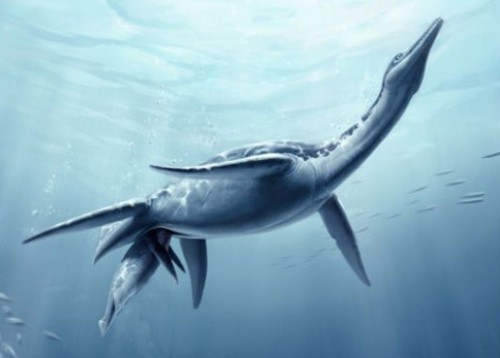
Plesiosaur |
|
Now it is true
that lots of people claim to see something.
However, with the
increased frequency of cell phone cameras, one would
assume there
should be plenty of pictures by now... but there are
practically
none.
Even if the hypothetical creature were
not an air
breather, then there's the problem of food supply.
Assuming the monster exists, it would have to eat
hundreds of times the weight of all available life
in the lake just to survive.
Unfortunately, Loch Ness has hardly any fish
larger than your average thumb. That is
because there is little for fish to eat! Since
the lake is too deep for sunlight to penetrate to
the lakebed, little to no vegetation grows in it.
If the lake can't sustain large fish, how would it
sustain a plesiosaur?
Finally, how
exactly would the monster reproduce over all these
centuries? One would assume a breeding
population of giant underwater monsters would
consist of several monsters for mating purposes, not
just one.
The more
one thinks about it, the more implausible the legend
becomes. But after all those eyewitness
sightings, it becomes very difficult to not have
second thoughts. One is forced to wonder, "What
could it be?"
|
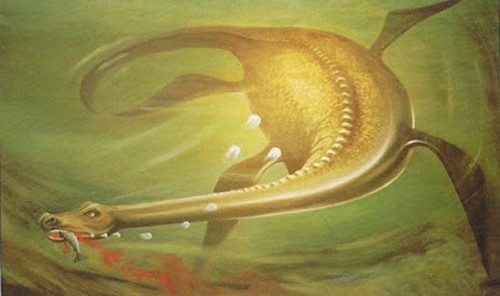 |
|
Origins
of the Loch Ness Monster |
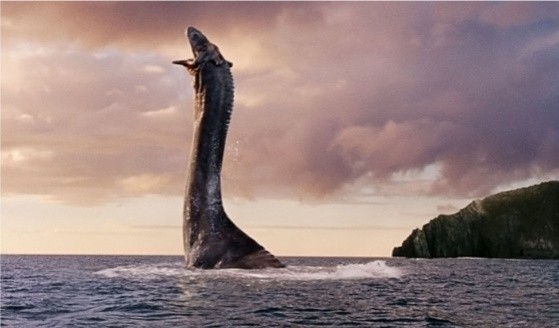 |
|
Legends of a monster in
Loch Ness have existed for over a thousand years.
Over the centuries there have been
several sightings. They all indicate some sort
of large fish. The Loch Ness Monster
is often called
Nessie, an anglicized version of
Niseag from Gaelic.
By
all accounts, the first written account of Niseag
appeared in
the
Seventh Century.
Saint Adomnán (627-704), abbot of
Iona, wrote a biography called
The Life of St. Columba.
Adomnán reported that
in 565 AD an Irish saint named
Columba had
saved a man from being attacked by the Loch Ness monster
simply by making the sign of the cross and commanding the
beast to retreat.
Comparing the date of the biography's publication to the
event itself, there is a gap of about one hundred years.
 |
According to Adomnán, the Irish monk
Saint Columba was
staying in Scotland, the land of the Picts,
with his Irish companions when he
came across the locals burying a man by the River Ness. They
explained that the man had been swimming the river when he
was attacked by a "water beast" that had mauled him and
dragged him under.
They tried to rescue
him in a boat, but were able only to drag up his corpse.
Hearing this, Columba stunned the Picts by sending his
follower Luigne moccu Min to swim across the river.
Immediately the
beast came after him, but Columba made the sign of the Cross
and commanded: "Go no further. Do not touch the man. Go back
at once!"
The beast immediately halted as if it had been
"pulled back with ropes" and fled in terror.
Startled by the spectacle of the beast cowering before
Columba's confident command, both
Columba's men and the pagan Picts praised God for the
miracle.
|
1933 - The Mystery
Begins with a New Road
|
The series of
lakes known as the Great Glen form a long waterway
between giant mountains. These rugged mountains overlooking
the lakes made building a roadway very difficult. Not
until the 1930s did Scotland finally undertake a project to
blast a road out of the mountains that parallel the lake.
In 1933, the
new road A82 was
finally completed along the
waters of Loch Ness. This
shoreline-hugging path afforded
drivers a clear view of the lake. Some
say the massive rock debris falling into the Loch must have
surely awakened the sleeping monster. Almost
the moment the road opened, a
series of very strange sightings began to occur.
Four sightings
in particular were widely reported in the press.
1
April: Aldie MacKay
2 July: George Spicer
3 August: Arthur Grant
4 December: Hugh Gray
|
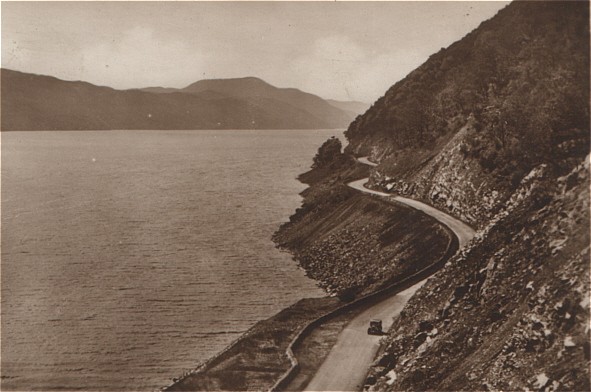 |
|
| |
|
April 1933 -
Event
1: Aldie Mackay
|
On April 14, 1933, Mr and Mrs John
Mackay, proprietors of the Drumnadrochit Hotel, were
returning home from a trip to Inverness. It was about 3 pm
when Mrs Mackay pointed to the lake and said, "What's that,
John?"
The water in the middle of Loch Ness was in a state of
commotion. At first Aldie Mackay thought it was two ducks
fighting, but then she realized there was no way
a duck battle
could cause a disturbance so widespread.
As her husband slowed down, the two of them watched
incredulously as a creature swam towards the Aldourie pier
on the opposite side of the lake.
For a brief moment they glimpsed two black humps which rose
and fell in an undulating fashion. The creature then
suddenly sank beneath the water and did not reappear.
The Mackays
stared at each other incredulously. Shaking their
heads in disbelief, they had a hard time accepting what they
had just seen.
|
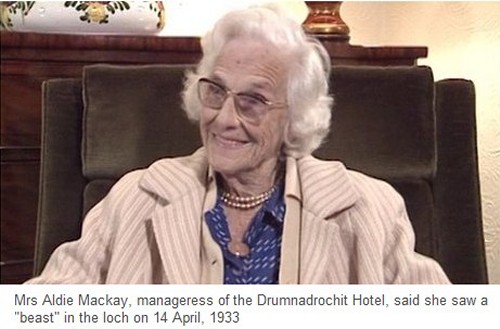 |
The Mackays
made no attempt to publicize their story.
However,
gossip about the sighting reached
Alex Campbell, a young water bailiff
(policeman). Campbell
was understandably very curious.
Since he happened to be a local correspondent for the
Inverness Courier, he called upon the Mackays who agreed
to share their tale.
The story appeared in the paper
two weeks later.
The editor is said to have
commented, "If it's as big as they say
it is, it's not a creature,
it's a monster!"
And that is how the Loch Ness
Monster acquired its name.
July 1933 -
Event 2:
George Spicer
On a hot
summer afternoon, July 22, 1933, Mr and Mrs George Spicer
were in the Loch Ness area on
their way back to London after a holiday in the Highlands.
Around 4 pm
they were driving along the Loch Ness Lakeshore Road
when
they spotted a huge, black
long-necked creature that stretched
across the road.
They stopped the car and watched from 200 yards away.
To their surprise, they
realized this massive object was in motion. They gasped when
they realized they were looking at a long neck. This was
soon followed by a grey body about five feet high. It moved
across the road in jerks.
|
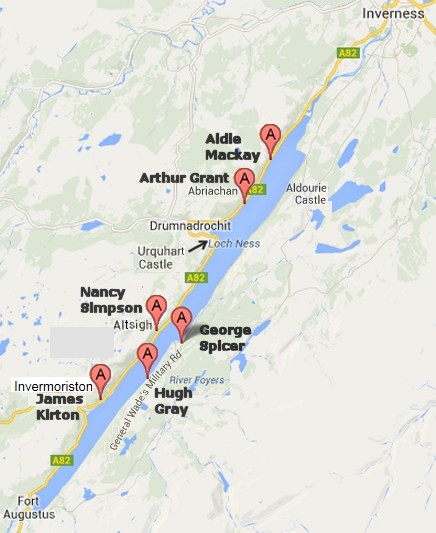 |
On 4 August 1933,
the Inverness Courier
published the assertion of a London man, George Spicer,
that he and his wife had seen 'a most extraordinary
form of animal' cross the road in front of their car.
After reading
the Courier report,
Commander Rupert Gould, a man
researching the Loch Ness Monster,
asked to interview them as well. Gould's account is
considered the most thorough.
George Spicer offered vivid details to Gould.
"It was horrible, an
abomination!"
He
described it as a "huge snail with a long neck, but with no
tail.
It
was the nearest approach to a dragon or pre-historic
animal that I have ever seen in my life."
|
The creature stood
about 4 feet high and was
25 feet long. It had a long
narrow neck that slightly thicker
than an elephant's trunk and as long as the width of the
road (about 10-12 feet wide); the neck had a number of
undulations in it.
Because Spicer
and his wife were on a slope, they could not see
whether it had legs or not. By the time their car had
reached the top of the slope, it had vanished into the
undergrowth opposite.
Spicer said the animal trundled across the road
toward the Loch carrying "an animal" in its mouth.
It was later
suggested to be perhaps a dead sheep.
Gould said when he first heard of
this newest sighting he was dubious, but after speaking with
the Spicers at their London home, he had
no doubt they were
telling the truth. He described them as still shaken and
upset. He also noted that as "Londoners", they had no
knowledge of the local legend.
|
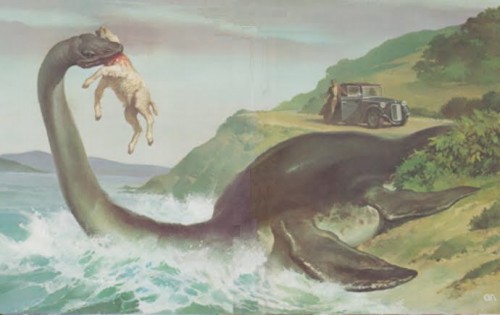 |
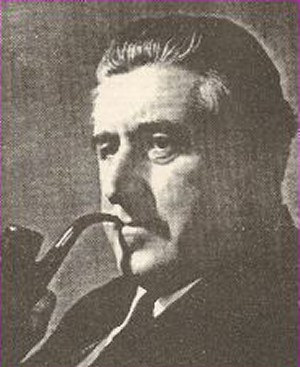 |
(Footnote:
Rupert T Gould was a lieutenant commander in the British
Royal Navy. He was taken by George Spicer's earnestness in
relating this strange story; Spicer's sincerity struck a chord in
him. Thanks in large part to his meeting with George Spicer,
Gould would take a lifelong interest in the Loch Ness Mystery.
Gould became one of the
first to systematically investigate the Loch Ness Monster.
After the Spicer talk, Gould set off from Inverness on a motorcycle
on 14 November, 1938, and circled the Loch twice over a period of
days (a round trip was close to 50 miles). He interviewed as many witnesses as possible, including the Spicers. He investigated various theories for the sightings,
such as the idea that the monster was a prehistoric creature, or
perhaps a normal sea animal that had swum into the loch by accident.
The book which resulted from his travels is highly detailed and
includes reports on all known sightings, including some that
occurred prior to 1933. It is copiously illustrated; all three
of the photographs then believed to be of the monster are included,
in addition to numerous sketches based on eyewitness accounts.
Gould put all his
notes together and transcribed the first major work on the
phenomenon, entitled The Loch Ness Monster and
Others, a 1934 collection of several eyewitness accounts.
|
The book
proved to be a big hit. After
his book was published,
Gould's interviews with people like
Arthur Grant and George Spicer became the definitive
lore to be repeated over generations. Consequently
Gould became the de facto spokesman on the
subject. He was a regular
contributor to radio shows and newspaper articles
any time the subject of the Monster came up.
Gould’s
conclusion was that there was a creature living in Loch
Ness. He is remembered as one of the earliest and most
thorough of the Loch Ness investigators. We all have
him to thank for the preservation of so much early information
relating to the creature and the many people who saw
whatever it is they saw.)
|
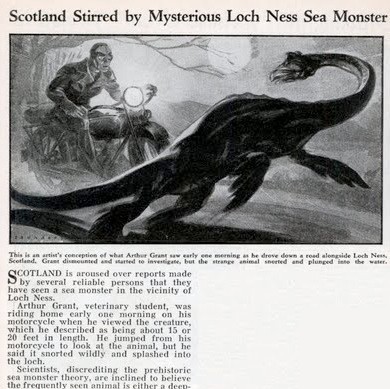 |
August 1933 -
Event 3:
Arthur Grant
In August
1933, a motorcyclist named Arthur
Grant claimed to have nearly hit the creature while
approaching Abriachan on the northeastern shore
around 1 am on a moonlit night.
Grant claimed that he saw a small
head attached to a long neck, and that the creature saw him
and crossed the road back into the loch. A veterinary
student, he described it as a hybrid between a seal and a
plesiosaur.
Grant said he dismounted and
followed it to the loch, but only saw ripples.
|
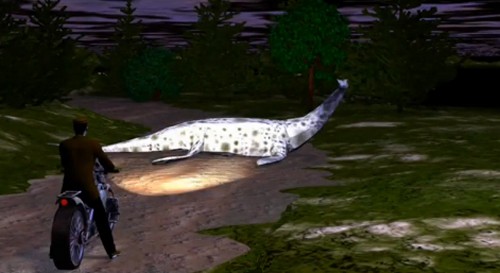 |
|
| |
|
December 1933
-
Event 4:
Hugh Gray's Photograph
Hugh Gray is well known in Loch Ness Monster
circles as the man who took the first photograph of the Loch
Ness Monster. The event took place around noon on
November 12, 1933, near the mouth of the Foyers River
(see map)
The Daily Record printed his picture as well as Mr.
Gray's account.
"Four Sundays ago after church I went for my usual walk
near where the Foyers river enters the Loch. The
Loch was like a mill pond and the sun shining brightly.
An object of considerable dimensions rose out of the
water not very far from where I was.
I
immediately got my camera ready and snapped the object
which was two feet above the surface of the water. I did
not see any head, for what I took to be the front parts
were under the water, but there was considerable
movement from what seemed to be the tail, the part
furthest from me.
The object only appeared for a few minutes then sank out
of sight."
|
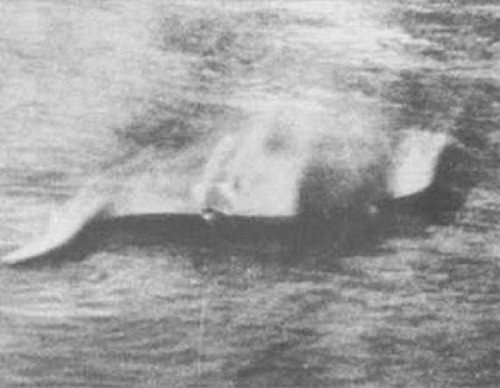
Hugh Gray's picture.
Hmm. What exactly are we looking at here? The Blob?
|
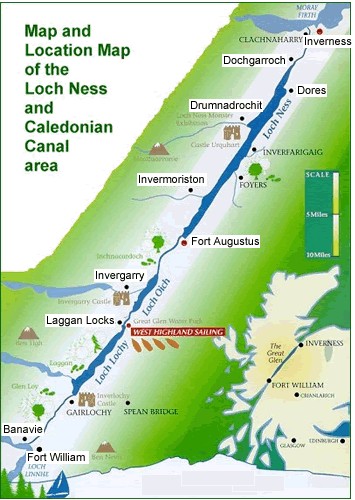 |
Hugh Mackenzie, the future Provost of Inverness, conducted
Gray's interview.
Peter Munro was present as well. Munro was
representing Hugh Gray's employers at the British Aluminium
Company. Munro was along as a character witness as to
Gray's integrity.
Whatever Munro said must have impressed Mackenzie because
Mackenzie went on to describe Hugh Gray as a man highly
respected by his fellow workmen, employers and locals.
Bolstering Gray's credibility, the Daily Record had
the negative examined by 4 experts who deemed it as
untampered.
Over the years, Hugh Gray never once backed down from his
story. Tim Dinsdale, another major Loch Ness
researcher, recounts in his book Loch Ness
Monster how he visited Hugh Gray in April 1960. Dinsdale described Gray as "a most courteous individual" as
he took him to the spot of the sighting.
According to Dinsdale, Hugh Gray spoke with "complete
conviction" about the events of that day.
Despite the
passage of time, not once did Gray wander from the same
details he had stated in his original story from 37 years
earlier. Indeed, Gray spoke as if the same thing had just
happened yesterday. It was permanently seared into his memory.
|
|
A Second Account of Hugh Gray's Photo
In November 1933 the creature was
photographed for the first time. Hugh Gray, an employee of
the British Aluminum Company, was walking on a wooded bluff
about 50 feet above the loch. Like George
Spicer, Gray was near Foyers as well.
Gray had seen the monster on a previous occasion and
consequently now carried his camera with him everywhere. On
Sunday, November 12, 1933, Gray sat down for a moment to
look out over the loch. It was a clear, sunny morning and
Gray could see all the way across to the northern shore
without a problem.
|
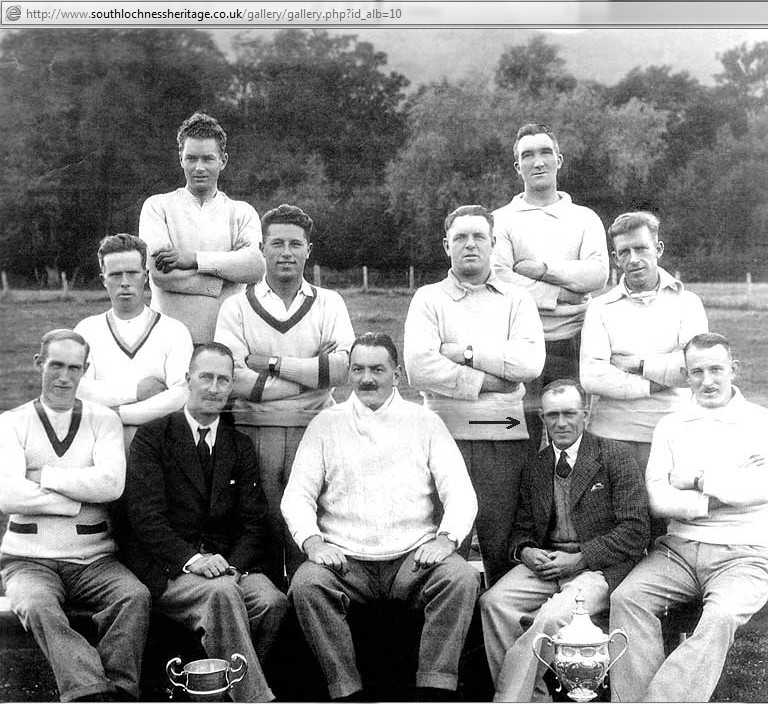 |
As he stared at the water, he saw
the creature rising up out of the water about two hundred
yards away. Gray raised his camera and snapped while it was
two or three feet above the surface. The creature quickly
dropped back down out of sight.
Gray was ambivalent about what to do next. He was very
worried about being subjected to derision, an instinct that
would prove painfully correct.
Gray left the film in his camera
for two weeks. Finally his brother couldn't stand the
suspense any more, so he took the film from Gray and handled
it himself.
After Gray saw the results, he was disheartened. He had
taken five shots. Unfortunately, his shots were
blurred because he had hurried
too much. The best
shot showed only a vague, grayish bulk. Gray's other
four shots were even worse.
The blurred shot of the beast appeared in the Scottish Daily
Record and the London Daily Sketch on December 6, 1933,
along with a statement from the Kodak film company that the
negative had not been retouched.
As Gray feared, the critics came out in droves. Professor
Graham Kerr, zoologist at Glasgow University, declared that
the picture was utterly unconvincing.
Kerr said he couldn't even tell if it was actually a
depiction of any living thing.
|
|
1933 - Monster
Fever Builds
1933
had been quite a year for the Loch Ness Monster.
It
had all started with Aldie Mackay. Then came George
Spicer. Next up was Arthur Grant. Then came Hugh
Gray. There were several other sightings as well.
For
example, Hugh
Gray's
photo was listed as the 25th report of the year.
There was so
much happening that people could hardly catch their breath. Indeed, on November 23, just a few
days after
Hugh Gray's
sighting, there was yet another event.
Dr. James
Kirton and his wife were walking down the hill behind
the Invermoriston Hotel when they saw a creature
swimming away from them. They saw a rounded back with a
protuberance in the middle. It seemed to them to be "like
the rear view of a duck in a pond", but much larger of
course. Commander Gould
registered the Kirton's observation as 1933's
26th sighting.
One week later came the
incredible 27th
sighting. Miss Nancy Simpson saw the monster lying motionless in the water
for ten minutes in an area near Altsigh. She judged
its length to be about 30 feet long. Then she saw it swim
underneath to the center of the loch "at the speed of an
outboard motor boat".
|
As one would imagine, Monster Fever was now rampant in
Inverness.
Public interest started gradually during the spring of 1933
with Aldie Mackey's report,
then picked up sharply after Mr and Mrs George Spicer
reported seeing the creature lumbering across the shore
road.
By October, several London newspapers sent
correspondents to Scotland. Radio programs were being
interrupted to bring listeners the latest news from the
loch. A British circus offered a reward of £20,000 for the
capture of the beast.
Hundreds of boy scouts and outdoorsmen
arrived, some venturing out in small boats, others setting
up deck chairs and waiting expectantly for the monster to
appear.
Hunters began flocking to Loch Ness in the hope of capturing
the monster. One man said he was "determined to catch
the monster dead or alive". Another hunting party
claimed they were having a special harpoon gun made and
would return with 20 "experienced men" to track the monster
down.
|
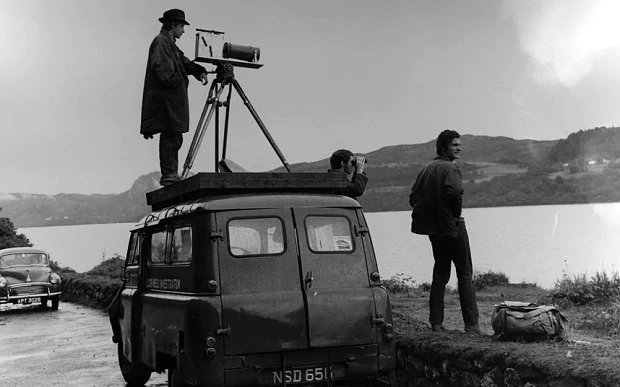 |
This development alarmed everyone. Everyone agreed
that as the creature was popular with the public, it would
be better not to kill either it or the myth.
There was so much certainty that a creature did indeed exist
that in Parliament, the House of Commons debated what sort
of protection might be afforded the monster. Documents
show consideration was given to issues such as stationing
observers round the loch to capture Nessie on camera and
whether it would be possible to trap the monster without
injury.
"That there is some strange creature in Loch Ness seems now
beyond doubt, but whether the police have any power to
protect it is very doubtful."
|
|
|
|
December 1933
- Marmaduke Wetherell
In just one year, the story had
infected all of Great Britain. Indeed, the story had
spread to most of the planet as well. This frenzy set
the scene for perhaps the most incredible story of all.
Into this super-charged atmosphere appeared a former soldier
of fortune with the improbable name of Marmaduke Wetherell.
The world would never be the same.
Marmaduke (“Duke”) A. Wetherell
(1884-1956)
was a flamboyant Fleet Street figure.
A born self-promoter, some
called him a rogue and a scalawag.
His dubious reputation aside, Duke was a character so profoundly absurd
that a movie should be made about him... or at least a
statue in his honor should be erected for his part in
creating the Loch Ness Monster legend.
The most extensive account of Wetherell on the Internet can be found in a strange article concerning the making of the
1917 movie
Rose of Rhodesia. Duke Wetherell was the
lead actor in the movie.
Yorkshire-born Marmaduke (“Duke”) A. Wetherell began his
career overseas as a frontier policeman in the
Bechuanaland Protectorate (Botswana).
Returning to England, he acted in northern repertory
theaters and spent a couple of
years in North-Western Rhodesia (Zambia) as a pioneer
farmer at Choma before taking
to the stage again in 1912 with Leonard Rayne’s South
African touring company. He was “loaned” to AFP in 1916,
appearing as a lead character in most of their films,
and played an active role in the production of A
Border Scourge in Swaziland over Christmas and New
Year of 1916-17.
According to one report, “Duke” had got on splendidly
with Labotsibeni, the
sage old Queen Mother of the Swazi.
|
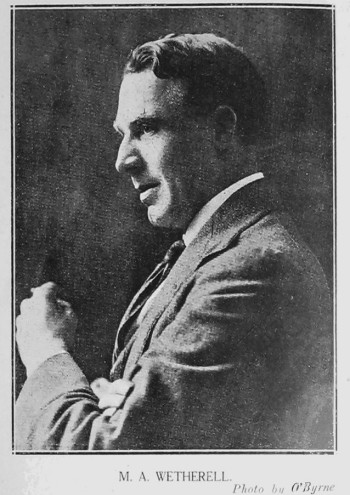 |
|
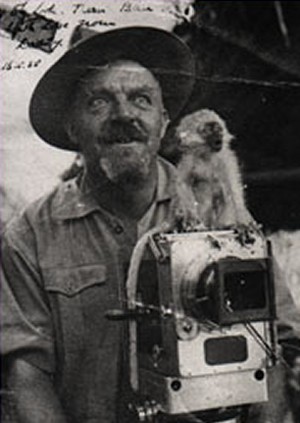 |
Born in
Yorkshire up in the northern part of England, Duke Wetherell
spent much of his 20s and 30s overseas in Africa.
First Wetherell was a policeman. Then he was an actor
in the 1917 silent-film classic Rose of Rhodesia
(we've all seen that one, right?). There are even
suggestions that Wetherell was once the boyfriend of
Labotsibeni, the most famous African queen in the world.
After his acting
career tailed off, Wetherell morphed into a big-game hunter
and safari leader. Later in the 1930s, he became a
writer, director, and producer back in England. Or so
he says.
If a movie is
ever made about the story behind the Loch Ness Monster
furor, Duke Wetherell has to be the lead role for sure.
One can easily visualize the hype:
"This
is the incredible story of an
cop turned actor turned big game hunter turned monster
hunter. Doc Savage and Indiana Jones, meet Marmaduke Wetherell... khaki shirt, bushy beard, monkey
perched on shoulder, wide brimmed hat, maniacal stare,
monster beware!"
For a man who
led a wild and colorful life, Wetherell would
become most famous for permanently etching the Loch Ness
Monster legend deep into the hearts and minds of the entire
world.
Who
better to track down an elusive
dinosaur than our brave hero,
Marmaduke Wetherell, the infamous
big game hunter from the deadly jungles of
Africa?
|
|
|
The Hunt for
Nessie Begins
Rick Archer's Note:
Much of the following account was written by Tony Harmsworth
in his book "Loch
Ness Understood"
The
flurry of 1933 dinosaur sightings
had captured the public's imagination in
a big way. People were hungry for information.
The London-based
newspaper Daily Mail was
hot on the trail of the story.
Even the slightest
mention of the Loch Ness Monster was huge for sales.
Now the Daily Mail was
no longer content to simply wait for new
stories to break.
They wanted to
stir things up a little. So in December 1933 the paper
decided to send an expedition up
to Loch Ness. They found the right man to lead the
chase.
Wetherell wasted
no time. On December 18, he set off
for the loch
with an entourage of reporters.
He also brought along a Daily Mail
photographer named Pauli to better
document his glorious adventure.
|
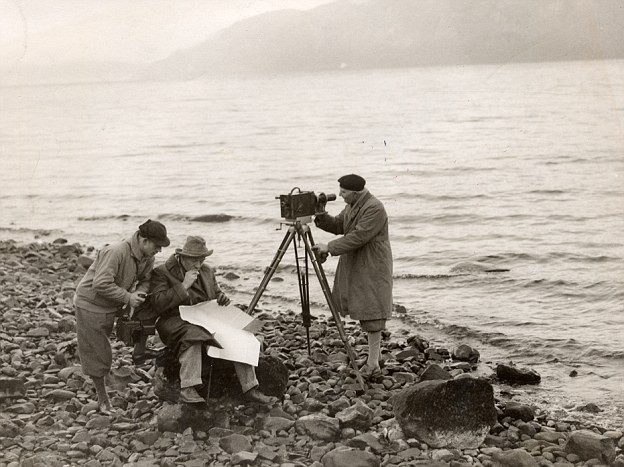 |
|
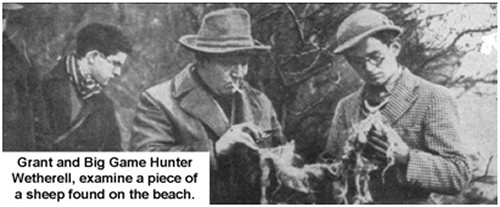 |
Wetherell seemed very confident. He even
chartered a motor vessel called the
Penguin in case it became necessary to pursue the
monster across the loch. Wetherell
said he wasn't going to just photograph the beast, he would
even try to capture it if the opportunity presented itself.
Wetherell's next move was to
enlist the help of young Arthur Grant,
the veterinary student who had nearly run into the monster
while riding his motorbike several months back. Wetherell asked Grant to
show him the spot where the creature had been sitting in the
road near Abriachan.
|
After just 48 hours of searching, Wetherell found
fresh footprints on the loch's
beach of a large, four-toed animal. Based
on the stride between these
newly laid footprints, this
suggested to his experienced stalker's eye "a very powerful
soft-footed animal about 20 feet long."
Wetherell added that this track was less than a few hours
old.
Even better, thanks
to Wetherell's foresight to bring a photographer along, his
friend Pauli was Johnny on the spot to immortalize the exact
moment that Wetherell discovered giant footprints in the
sandy
dirt.
That was fast! People
throughout the Loch Ness community were
impressed at how quickly Wetherell had made progress.
Was it just good fortune
or was it Wetherell's great skill
as a big game hunter which enabled him to discover
those rather large
footprints nearby?
Whatever the answer, his skill was
simply amazing.
|
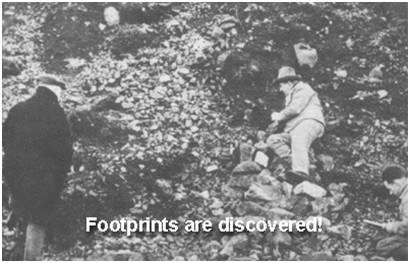 |
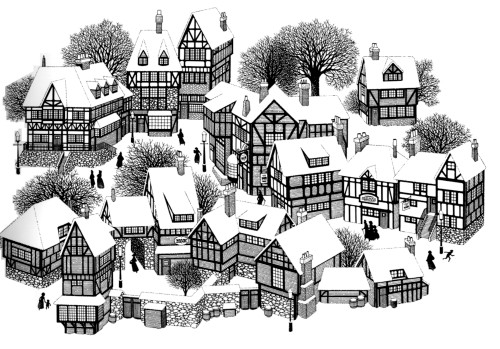 |
With great fanfare, Wetherell made
plaster casts of the giant
footprints.
Shortly before Christmas
Eve, he sent
them off to the British Natural
History Museum in London for analysis.
The Daily Mail printed every detail and electrified the
country. The
odd timing of Wetherell's discovery made for a very unusual
Christmas Season in Merrye Olde England.
People were so
excited they could hardly contain themselves. However,
the examiners told everyone to calm down; they would need
some time to study these prints. Besides, it was
Christmas. People would just have to wait. After all, they had families too!
Forced to wait
for the museum’s verdict all through Christmas and into the
1934 New Year, no one had the slightest bit of patience.
While the world waited for the museum zoologists to return
from holiday, legions of monster hunters descended on Loch
Ness, filling the local hotels.
Inverness was
floodlit for the occasion and traffic jammed the shoreline
roads in both directions. Santa Claus was spotted near
the lake twice.
|
|
Calm down? As for the
Daily
Mail, it wasn't going to wait.
Far from it! Heck, their very own guy had broken the
Monster story wide open with his footprint discovery.
Marmaduke
Wetherell had been hired in December 1933 in part due to his
boast that he could produce fast results. Now that the
big game hunter had delivered, they weren't going to sit on
the scoop of the century for nothing!
Pictured is the
Daily Mail's famous headline. Note the date on the
paper is December 21, 1933. This was the issue where
the Daily Mail broke the news of Wetherell's amazing
discovery. The world was on fire with Monster Fever.
All that was
left now was the wait for the upcoming Museum announcement.
That seemed a certainty. Surely the experts would confirm
the footprint conclusively proved the existence of a
dinosaur-like amphibian living in the Loch Ness waters.
The excitement was unbearable.
It took ten
days, but finally the suspense was over. The British Museum
said it was ready with an announcement.
|
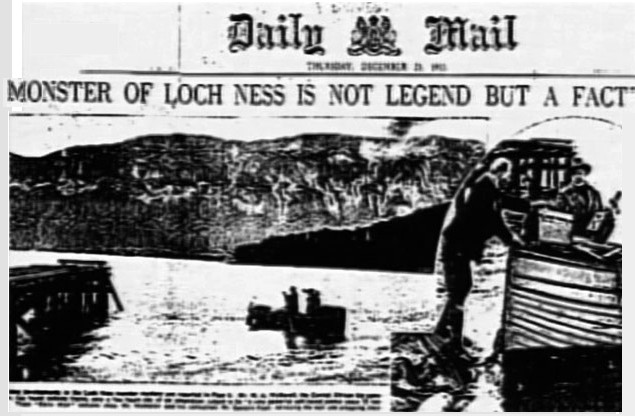 |
A breathless army of reporters rushed over
to report the big
news. The Museum said their analysis had shown that
the footprints were entirely consistent with that of a
somewhat shriveled hippopotamus foot.
Hippopotamus? What exactly was a
hippopotamus footprint doing next to the spot where Arthur
Grant had spotted the monster? There had been 27
sightings of the Monster in 1933 and not one of them
suggested a hippo.
Many theories
abounded about the source of this foot and all sorts of
explanations were provided. These suggestions ranged
from a local person’s umbrella stand to the possibility that
a circus had passed by and allowed a real hippo to go for a
swim.
The circus
theory claimed that over the years many traveling circuses
had used the road that runs parallel to the loch. They
theorized that larger animals such as hippos and elephants
were set free to cool off and wash in the waters of the
loch. In fact, perhaps the alleged serpent was in
reality just your average elephant going for a swim,
resulting in what looked like some sort of monster from a
distance.

It wasn't
difficult to poke holes in this theory. For one thing,
what sort of African-born hippo or elephant wants to "cool off" in the
icy Loch in December? The poor animal would surely
either freeze to death or at the minimum get sick.
And what circus
lets its valuable elephants swim free in the Loch?
What if Babar doesn't want to return? Then what?
Just how exactly does one coax a giant elephant into coming
back on shore? Play bagpipes?
These circus
theories were so preposterous that almost overnight the
entire planet lost its patience with the monster stories.
Most people thought there was a much better explanation...
someone had obviously planted that mysterious footprint and
that person was probably Marmaduke Wetherell!
Every newspaper in Great Britain had a field day with that
one... except the London Daily Mail of course.
The editors there didn't see any humor at all.
Wetherell explained to the Daily Mail
that he himself had
been hoaxed by the fake hippo print.
Nonsense. The paper didn't believe a word he said.
Now that Wetherell had made himself as
well as the Daily Mail the laughing stock of the nation, the
Daily Mail promptly sacked the amazing big game hunter...
and apparently they weren't delicate about it either.
Embarrassed and humiliated, Wetherell
became bitter over
his treatment by the paper. He slunk back to
Twickenham a bitter and beaten man.
Marmaduke and the Daily Mail weren't the only ones
crimson-faced with shame. The entire Inverness area
had become the butt of the joke for the whole world. It
wasn't easy, but most people had been willing to keep a
straight face when Hugh Gray's picture of the blob was first
published.
However, the
sheer absurdity of the circus explanation pushed everyone
completely over the edge. In the blink of an eyelash, the
farce surrounding the fake hippo footprint switched the
Monster story from serious business to great mirth.
People began to giggle.
Soon the
outburst of hilarity was absolutely seismic. It had taken
the work of only one idiot like Wetherell to change the
entire world's perspective from excitement and fascination
to ridicule. Once the monster rumor was seen in this
new and far less flattering light, the Inverness area was
taken to task for trying to dupe the world with their
ridiculous fish tale.
Cartoons mocking
the monster legend began to appear
in newspapers around the world. Everyone had a good
laugh and pretty soon the story completely vanished from the
papers.
Monster Fever
was done with and put to rest. Or so they thought...
|
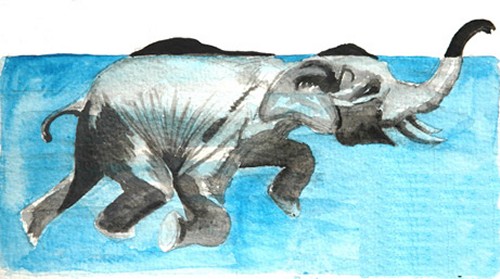
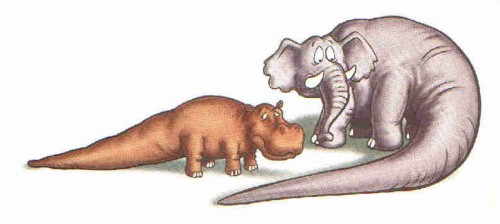
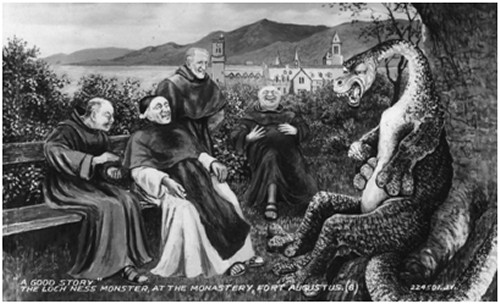
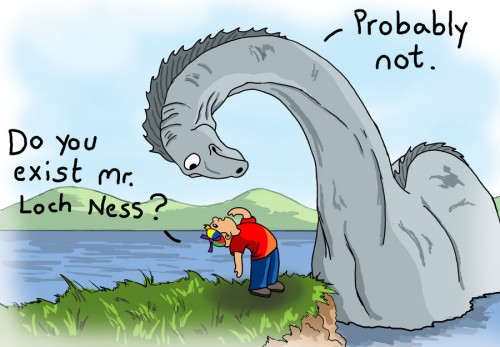 |
1934 - The Surgeon's
Photo
|
The furor had barely died down when
suddenly the Loch
Ness Monster came roaring back to life. Only four short
months had passed since the footprint scandal when a new
development shocked the nation.
On April 21,
1934, the iconic picture of the monster first appeared
in the London Daily Mail.
The sensation this photo caused was practically cataclysmic.
People were dumbfounded. Seeing was definitely
believing.
"Oh my
gosh, it's real! The monster is real! I can't
believe it. It's really real after all!"
The story behind
the famous picture involved Colonel Robert Kenneth Wilson, a
highly respected London-based gynecologist. Wilson had
quietly come forward to present the London Daily Mail
with a picture that appeared to show a sea serpent rising
out of the water of the Loch.
Wilson said he
took the photograph early in the morning on April 19, 1934,
while driving along the northern shore of Loch Ness.
Returning from a hunting trip, Wilson noticed something
moving in the water and stopped his car to take a photo.
|
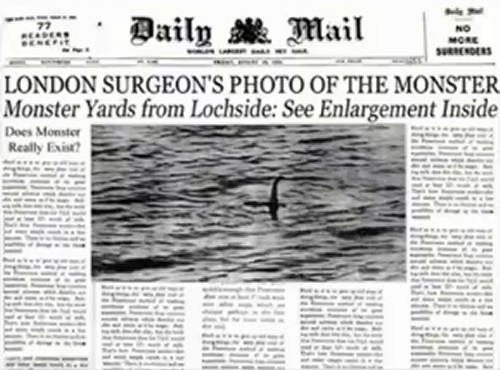 |
Wilson turned
out to be rather skittish about his remarkable photograph.
He preferred the
paper keep his identity a secret. Wilson did not
mind accepting money from the paper in exchange for rights
to his valuable photograph, but oddly enough, he refused to
allow his name to be used. When asked, he said the lady
companion along with him that day was a married woman... but not
married to him...
Meanwhile, since
"gynecologist" didn't have the right ring to it, the Daily
Mail named it The Surgeon's Photo.
Copies of
the photo quickly appeared in
newspapers around the world,
captivating people in every distant corner of the planet.
Besides the
excitement, it didn't take long for
the burning question
to be raised. How valid is this photo? The
debate began; this became the most controversial
topic of the day.
Not
surprisingly, the
skeptics came out in droves. Their patience with this
nonsense was completely exhausted. They didn't believe
the picture was legitimate. Plus the footprint scandal
had left a bad taste. Fool me once, shame on
you, but fool me twice, shame on me.
However, the
iconic image managed to withstand the challenge.
Although it never actually proved the existence of the Loch
Ness monster, it was sufficiently compelling to nourish the
legend and shake the doubters. For one thing, this
time the new evidence managed to win over many of the
scientists. Scientific experts were called in to
examine the photo and they declared it could be a
plesiosaur. They also mulled over the wave patterns
and concluded the beast was definitely on the move, adding
to the picture's authenticity (a stationary photo would be
easier to fake).
Meanwhile the
London Daily Mail stood firmly beside its image.
Unlike the fake hippo print, this photograph proved much
more difficult to question and to prove false. Even
better, the public was on their side. To
their satisfaction, the public was by and large completely
convinced this photo was the real thing.
When asked who
had taken the picture, the editors referred to the
impeccable reputation of the source. They told anyone
who asked that the man who brought forward the picture did
not wish to have his privacy violated, but that he was an
upstanding pillar of the community.
Of course, the
mystery of the man's identity simply reinforced the
skeptics' belief that the London Daily Mail would stop at
nothing.
So who was this
mystery man?
|
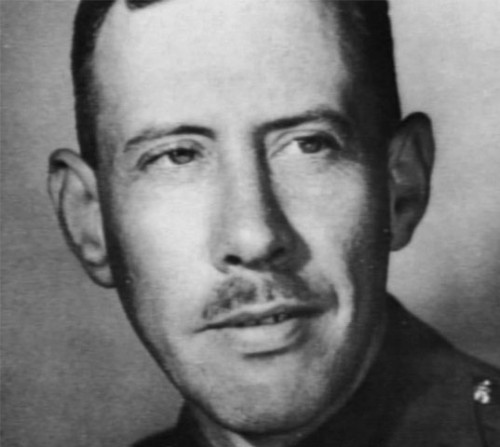 |
Lt Colonel Robert Kenneth
Wilson (1899-1969) fought in both world
wars. Wilson
was no ordinary pencil pusher who barked orders from a safe,
comfortable office in London.
In WW I, Wilson had seen action at the front lines and
received several promotions. In the upcoming WWII,
Wilson would join the Special Operations Executive
to parachute behind enemy lines into Holland, France and
Borneo. He was obviously a very
brave man.
Wilson
was a well-known expert on
firearms. He was asked to
lecture on ballistics at the Old
Bailey during the 1930s. He also wrote a definitive text on
automatic pistols with editions published in 1943 and 1975.
Wilson was also
an accomplished physician.
He was an Edinburgh Fellow
of the Royal College of Surgeons (1926) who had a
practice in general surgery and gynecology
on Queen Anne
Street and Harley Street during
the 1930s.
In other words,
R. Kenneth Wilson, MD, wasn't your average witness. He
was a highly respected member of the London medical
community. If Wilson said he had taken a photo of the Loch
Ness Monster, the London Daily Mail was not ready to
rigorously interrogate the good doctor.
And why should
they? This photograph was worth a king's ransom.
The paper's circulation was at an all-time peak. It
was hardly in their best interests to ask too many hard
questions.
|
This photograph would become the defining image of the Loch
Ness.
The picture itself was riveting. In
many ways, the monster's new picture far exceeded the
imaginations of most people. Previous descriptions had
included unflattering words such as "beast, abomination,
snail-like".
Instead what people
saw now was
a classic portrait of an upraised head and
long slender neck held over the
waterline. To everyone's surprise, the
monster was as poised and
graceful as any swan, yet
decidedly serpentine in its visage.
The subtlety of
the shadowed figure on the gloomy waters made a dramatic
impact.
People weren't afraid of it anymore.
As monsters go, whatever it was, it didn't seem particularly
dangerous. In fact, this lost-in-time creature seemed
vulnerable and very lonely. It evoked a type of
sympathy.
Furthermore,
people
could not help but look at the photo and think, "Hey, that's
a damn good-looking monster!"
As any fan of
Dracula will attest, if a monster is sexy and good-looking,
people will forgive a lot of things. And let's face it
- Nessie was very sexy.
The picture was
a real boon for the Monster Legend.
Without
this photograph, the legend may
very well have perished for good. Instead,
the goofy hippo prank was quickly
forgotten and the Faithful
returned. Hopeful viewers of a wild
spectacle flocked to the loch in
droves. Countless people lined the
shores with binoculars, cameras and picnic lunches to
peer out over the waters should
Nessie decide to reappear for an
encore.
|

The famous 1934 picture that started all the fuss
|
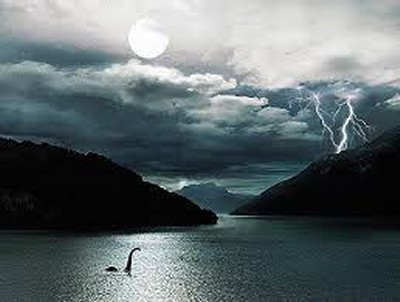 |
Thanks to the
Surgeon's Photo, the media had a field day.
The world had become totally infatuated with the Monster. In
fact, the picture had become so popular that the world
begged to know the identity of the hero who had snapped the
photo. Noting the fanfare, Wilson, the reclusive
surgeon, decided to come
forward and identify himself.
Do you remember
Rupert T. Gould, the man who interviewed
George Spicer? Apparently R Kenneth Wilson
contacted Gould and did an interview. In turn, Gould
put Wilson's "Surgeon's Photo" on
the cover of his book The Loch Ness Monster and
Others and published
Wilson's identity for the first time. This was quite a
coup for Gould and guaranteed his book would become a
best-seller.
No one can be
sure why Wilson chose to step forward, but people have
speculated Wilson originally wanted to escape the kind of
criticism and ridicule that had followed publication of Hugh
Gray's "Blob" photo. Once he realized his picture was a huge
hit, perhaps Wilson wanted to bask in the adulation for
breaking this mystery wide-open.
|
So what did
Rupert Gould learn from Wilson's report?
On April 19th,
1934, Wilson and a friend named Maurice Chambers were
driving northward (note that Wilson changed his story about
the 'married woman' who was his earlier reason for not
saying much). The two men had leased a wild fowl shoot
near Inverness and meant to take some photographs of the
birds.
Wilson had borrowed a camera with a telephoto lens for the
occasion. It was 7 am in the morning. They stopped the car
on a small promontory two miles north of Invermoriston.
As they stood watching the surface, they noticed signs of
'considerable commotion'. Wilson's friend Chambers shouted,
"My God, it's the monster!"
Wilson rushed to the car, came back with the camera, and
managed to expose four plates in such a hurry that he did
not even look at what he was photographing. The creature
almost immediately withdrew below the water surface.
Wilson
said he never got much of a look at it. Wilson claimed
only to have seen "something in the water" some
200-300 yards from shore.
Unsure whether he had captured
anything, Wilson hurried to town and took the plates to a
chemist named Morrison,
announcing that he had just seen
and photographed the Loch Ness Monster.
|
|
The first
two exposures were blank and the fourth
one lackluster. However the
third photo was exceptional; it
became the one known
worldwide as the "Surgeon's
Photograph".
Oddly enough,
the publication of Wilson's photo provided a closure of
sorts. People were much happier believing Wilson's
photo was legitimate after the disappointment of the fake
hippo print. It was obvious that the public wanted
there to be a Loch Ness Monster.
Regardless, the Loch Ness Monster
faded from public interest shortly afterward with the rise
of a far greater monster, Adolph
Hitler. As threats of a
Second World War
loomed ominously, people now had a far
more serious problem to concern themselves with.
Indeed, for the
next 60 years,
outside of the Inverness area,
Nessie was largely forgotten. There was
an occasional new photograph,
but none anywhere near as
compelling as Wilson's had been.
During this time, R Kenneth Wilson's picture became accepted
in the public's mind as the true picture of the Loch Ness
Monster. Wilson had
not only photographed Nessie, he had
immortalized her.
|
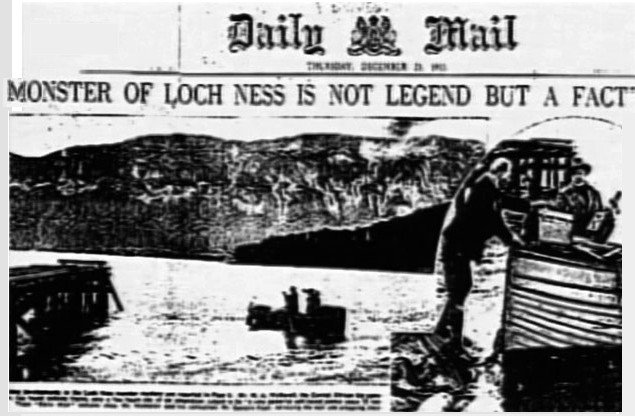 |
|
| |
|
1933 - 1993
60
Years Later, the Truth comes out.
|
For over half a
century, the Surgeon's Photo served as an enduring symbol to rally all true believers.
The photo was so compelling that the Believers based much of
their defense upon its validity. Whenever the Skeptics appeared to be winning the Nessie-doesn't-exist
argument, the Believers would trot out the cornerstone of
their defense, "But what about the Surgeon's Photo?"
Try as they might, thanks to that photo,
the Skeptics were getting
nowhere debunking the story in the court of public opinion. The Skeptics could churn
out dozens of scientific reasons why the Monster had to be a Myth,
but as long as that picture stood, the
Loch Ness Monster was Real in the public's eye.
In 1991,
researchers Alastair Boyd, a zoologist, and David Martin, a
writer,
were members of a scientific project dedicated to discern
the truth of the Loch Ness mystery.
Leaving no stone
unturned, they came across an obscure 1975 letter in the gossip column
of a British news magazine in
which Marmaduke Wetherell's son Ian claimed he and his
father had once fabricated a photograph of the monster.
|
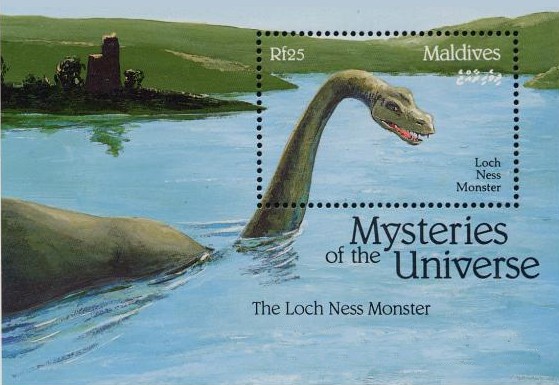 |
Ian Wetherell,
now 62,
had written a letter to Mandrake of "Sunday Morning with
Mandrake". (Note: Mandrake is the name of the long-established
social diary in The Sunday Telegraph newspaper).
Ian Wetherell related how
he had once helped his father and a man named Maurice
Chambers pull off a fake Nessie
picture.
"We found an
inlet where the tiny ripples would look like full size
waves out on the loch, and with the actual scenery in
the background. Then it was just a matter of winding up
the sub and getting it to dive just below the surface so
the neck and head drew a proper little V in the water."
Boyd and Martin
stared at the yellowed newsprint in shock. This December 7,
1975, letter in the Sunday Telegraph was a real
corker, but apparently the entire world had missed its
significance. Why had
they never heard of this before? And why didn't anyone
follow up on it?
At first
thought, they assumed that no one knew how to put two and
two together.
First, the
monster's existence wasn't exactly a burning issue in 1975.
No one was keen on the Ness monster at the moment. So
'apathy' was one explanation.
Second, Ian
Wetherell did not specify which particular photograph of the
monster he was speaking of. Since there were at least
a dozen or more possibilities to choose from, no one suspected this
might have something to do with the most important photo of
all, the Surgeon's Photo.
Finally, most
people reading the paper had not the slightest idea in 1975 that the "Wetherell"
name had been intimately connected to the monster from back
in 1934. Consequently the average citizen never gave
the admission a second thought.
What
really aroused Boyd and Martin's curiosity were two
unusual facts contained in the letter. Ian Wetherell had named Maurice Chambers as a part of
the conspiracy. Boyd and Martin remembered
Wilson had told Rupert Gould that Chambers was his
companion on the day he took photo.
Also Ian
Wetherell had mentioned that the photo
taken had included the far shoreline in
the image. Very few
people knew that the Surgeon's Photo was actually a
crop taken from a much larger picture that had a
stretch of the Loch
Ness shoreline in the background. However, Boyd and
Martin were well aware of this obscure fact.
This
letter had a definite ring of authenticity about it!
Then
Boyd and Martin stumbled on another mind-blowing
fact. They noted that the Loch Ness Phenomena
Investigation Bureau and Maurice Burton of the
Natural History Museum possessed copies of the
1975 article, but had not given the information any apparent
importance.
How
could this be? How could such an important
lead as this have slipped through the cracks?
|
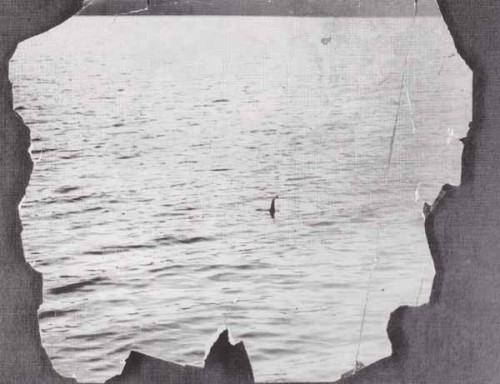 |
|
|
|
The more they
thought about it, the more bewildered Martin and Boyd
became. Staring them in the face was clear evidence
that certain authors of published works about the Loch Ness
monster were behaving suspiciously. These authors had
access to correspondence and other information that should
have made them realize the Surgeon's Photograph was a hoax.
But seemingly they had dropped the ball.
In Boyd and
Martin's opinion, it likely would have taken a willful
ignorance to ignore the true significance of what the
materials meant. This was too big an oversight to be a
mistake.
Then it dawned on them - there had
been a cover-up. Certain knowledgeable people had
deliberately chosen to suppress the truth about the
Surgeon's Photograph. Obviously they had their reasons
and agenda to allow the Surgeon's Photo to continue unchallenged.
Boyd and Martin
took a while to let that sink in. Both men continued
to shake their heads in disbelief. This was like a 4
year old learning there was no Santa Claus, but much worse.
They had dedicated their lives to uncovering the truth only
to find out they were being deceived by certain people they trusted.
After talking it
over, they decided they wanted to know as much of the truth
as possible. Unfortunately, sixteen years had passed
since the 1975 article. They knew Wilson, Chambers,
and Marmaduke Wetherell had already died. But what about Ian
Witherell? No luck. They soon learned that Ian
Wetherell had died five years earlier in 1986.
However, there
was one last hope. Christian Spurling, Ian's 89
year-old step-brother, was still around... but just barely.
David Martin
took the lead. Martin and his wife Jane met Spurling
and his wife Joy at Spurling's home in February 1991. To
Martin's undying relief, Spurling was more than willing to
talk about the Surgeon's Photo. Spurling said this whole affair had
been a prank cooked up by his stepfather Marmaduke Wetherell.
Spurling's key comment at that meeting was: "It's not a
genuine photograph. It's a load of codswallop and always has
been."
Spurling added
the popularity of the photograph had long been a source of
great amusement to his family. In other words, the
secret of the Surgeon's Photo was known to quite a few
people in the family circle, but no one bothered to share
this bombshell
with the outside world. Martin shook his head in
disbelief. With so many people aware of Marmaduke's
shenanigans, how had the truth stayed hidden for so long?
Boyd and Martin
decided there could be only one explanation. The truth
had stayed hidden this long because practically everyone
associated with the monster wanted it to stay that way.
Alistair Boyd
asked to participate in the follow-up interview. Boyd
and Martin visited Spurling in June 1992.
This time Spurling was ready to tell everything that
had happened down to the last detail.
Christian Spurling's Story
Spurling said he
had been 30 years old when the fuss and fury surrounding the
monster had reached its fever pitch. Like anyone else,
he and his younger stepbrother Ian, 21 at the time, had followed the events of 1933
in the paper closely. So did his stepfather Marmaduke
Wetherell.
In his youth,
Marmaduke had spent many years leading safari expeditions
through the African bush in South Africa and surrounding
areas. As a big game hunter, he was no stranger to
tracking large and very dangerous animals. Those had
definitely been his glory years. But Duke Wetherell was 50
now. Those days were long gone. Now Wetherell missed
the limelight badly.
As Spurling
explained, in the privacy of his home, it turned out Marmaduke
believed in the existence of the monster. In fact,
Marmaduke was obsessed with the monster. Almost daily
he would speak of his ever-changing theories about
the monster. One day it was a hippo, the next day a
giant
salamander, a rhino,
a giant tortoise,
a sturgeon or a seal.
Finally Duke Wetherell
couldn't take it anymore. He was itching to get
back in the game and he had an idea how to do it. He would approach the London
Daily Mail and offer his services tracking down the Loch
Ness monster.
Sure enough, he
set up an appointment. Duke Wetherell started the
interview by boasting
of his prowess in the African bush. He told stories how he
had led wealthy men deep into the wilderness and how he
always came through for them. He could track any
animal in the world.
However, the men
at the Daily Mail were very skeptical. Tracking a lion
in Botswana was one thing, but how did he expect to find an
underwater monster when not one local person in the area had
the slightest clue? Where was he going to look first?
What was he going to use for bait?
Wetherell was
unfazed. He confidently predicted he could pull this
off. Bankroll him for two weeks and he would guarantee
results.
The Daily Mail
editors rolled their eyes. This seemed like a waste of
money. However, that's when Wetherell reminded them
how people had said the same thing about Christopher
Columbus and look how that gamble had turned out.
In the end,
Wetherell's brazen confidence and fast-talk had won him the
job. The editors could not believe the brass of this
guy, but heck, why not? What did they have
to lose?
But now
Wetherell felt pressure to produce quick results. In
fact, he was worried he had bitten off more than he chew.
He was desperate for the attention any sort of discovery
would bring him, but he had no more idea how to find the
monster than the next guy. It wasn't like the monster
was going to leave bread crumbs in the water for him to
follow.
Now Christian
Spurling dropped a bombshell. It was Marmaduke's
desperation to justify his big talk quickly that had
prompted him to fake the hippo print in the first place.
Boyd and Martin
were incredulous. They could hardly believe their
ears. In the past, Marmaduke had always denied that he
had been the one to fake the footprint. So they asked Spurling to elaborate.
|
|
|
Spurling said
that the night prior to leaving for Loch Ness to begin his
expedition, Marmaduke had been talking about how important
it was to produce immediate results for the newspaper.
Marmaduke had already decided this expedition was his last
hope at a big score. He wanted to recapture the glory of his
youth when all cameras were focused on him. He was
determined to milk this opportunity for a long ride back to
fame.
As he
smoked a cigarette in his den, Marmaduke noticed his
solid silver ashtray was set on top of an actual
hippopotamus foot. Hmm. He picked it up and ran his
fingers over the four-toed base. The wheels of
his mind turned.
On the
spot, Marmaduke decided to pack the hippo ashtray
and bring it along with him. In other words,
Marmaduke Wetherell had come fully prepared to
create his own discovery. After exploring the
area for a couple days, one night Wetherell slipped out of his
hotel and returned to the investigation
area to make the footprints while there was no one
around.
Wetherell thought he was so clever. And then to his
dismay, he got busted by the Museum of Natural
History.
|
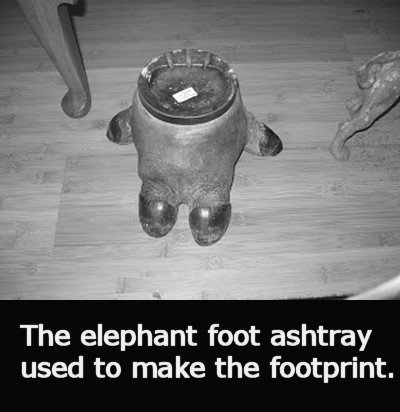 |
|
|
|
Spurling
paused for a moment. In fact, Spurling
suggested, the original
silver ashtray was probably still in the possession
of the Wetherell family. Spurling imagined
Boyd and Martin could track it down if they cared
to.
Then
Spurling
laughed. One of the amazing facts of Marmaduke's ploy
is that no one in the press had ever printed that the
footprints were all from the same left hind foot.
Didn't anyone find that a little bit strange?
And no one in
the press had pointed out that the hippo print from the
ashtray was less than half the size of an ordinary hippo's
foot.
If anything, the
Museum of Natural History had done Wetherell a real favor by
limiting their public criticism. When they called it a
"somewhat shriveled hippo foot", what they really meant to
say was that the footprint was nowhere near the right size.
Spurling laughed some more, then started up with more of the
tale.
|
|
|
Spurling said he
had not known in advance what his stepfather had tried to
pull off, but once he learned the truth, he was proud of
the old man. What a brilliant trick!
His stepfather
was quite a guy. He had more guts than any man he had ever
met. Marmaduke had attempted to fool the entire world
with an ashtray hippo print. How would anyone ever be
able to top that?
On the other
hand, his grandfather had been also been a real fool. In
retrospect, this hippo foot prank probably didn't have the
slightest chance in hell to succeed. Unfortunately,
Wetherell had simply not thought this through properly.
Too bad it
hadn't worked out. Nice try though!
Now Wetherell
had to face the music. The editors at the London Daily
Mail reamed him inside and out. Wetherell had ruined
the credibility of their paper. His stupid stunt had
made their paper not just the laughingstock of London, but
the entire goddamn world! What the hell was he
thinking?
Wetherell lamely
tried to bluster his way out by saying someone in the Loch
Ness area had played a dirty trick on him, but the editors
weren't buying it. They had correctly guessed that
Wetherell would say anything to save his skin. After
all, what was that nonsense about the footprint's "spoor"
being only a few hours old? Gosh, Marmaduke, are you
telling us you can't tell a hippo track from a sea monster
track? What were you DOING in Africa all those years?
That's when they
told him to get the hell out of their office and go jump in
a loch. Then for good measure, the Daily Mail printed
a story publicly castigating Wetherell for the entire
scandal. If the public wanted to blame someone for the
deception, go take it up with Marmaduke Wetherell, not the
paper.
Marmaduke was
incensed at the way those snobs at the Daily Mail had
treated him. No one had the right to talk to him like
that! No one had the right to publicly embarrass him
like that! He was completely and utterly humiliated.
Spurling paused
for a moment. He pointed out that Wetherell had a lot of
pride. He didn't handle some of the things those
editors called him very well. "Scam artist, buffoon,
rhino chaser, big talker." His oversized ego was badly
wounded. But the worst part was the public criticism.
Unfortunately, there wasn't much Wetherell could do to fight
back. It wasn't libel for a paper to tell the truth.
As Spurling put
it, "My stepfather was
an extrovert, an eccentric, a likeable rogue.
But most of all, he was a vain
attention seeker. The paper had insulted
him and slapped him the face. He vowed to get even."
|
|
|
Spurling
said his
stepfather had seethed for days on end. However,
rather than accept his humiliation was his own fault,
Wetherell decided the fat cats at the Daily Mail needed to
pay for their cheekiness. He was going to teach them a
lesson.
That is when
Marmaduke Wetherwell made his fateful decision. He
decided to pull one over on the smug bastards.
Muttering aloud, "We'll give them their monster," he and his
son Ian decided to stage a photo. They started by
purchasing a clockwork submarine and several tins of plastic
wood.
Next Marmaduke and his son Ian approached Christian Spurling
with the idea of creating a fake monster. Spurling was
brought in on the conspiracy due to his skills as an expert
model-maker.
"The fake
monster was modeled on the idea of a sea serpent," Spurling
recalled. Spurling decided to be careful. He
intended to make it took look as realistic as possible.
First he studied a book of dinosaurs. He picked the
plesiosaur since it best resembled various sketches of the
creature made back in 1933. Then he took his time
making the dinosaur look realistic.
In all, it took
him 8 days to build the model. Mounting the 12-inch wood
plastic sea serpent model on top of the 14-inch toy
submarine, he now had a miniature monster simulation way
ahead of its time, easily 60 years ahead of Spielberg's Jurassic Park dinosaurs.
Confident they
had done their job well, now they had to find a sponsor.
It would do no good for Marmaduke to prance back into the
London Daily Mail waving his photographs. For this to
work, they needed to find someone credible to sell their
photo to the world.
A mutual
acquaintance named Maurice Chambers, an insurance agent,
suggested Colonel R. Kenneth Wilson. Robert Wilson and
Chambers had leased a wildfowl shoot at the Beauly Firth
near Inverness. Maybe they could photograph the monster
model up near there, get it developed and then take it to
the paper.
Chambers
explained to Marmaduke that his buddy Wilson was extremely
fond of a practical joke. The surgeon would be a suitable
candidate since Wilson had a devilish sense of humor and
would be ripe for a good prank. Spurling didn't think
that wasn't much of a reason for Wilson to participate, but
apparently all it took was a suggestion from Chambers to get
Wilson on board. Chambers said Dr. Wilson was game to
give it a try.
|
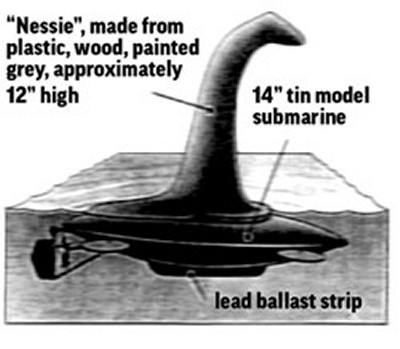
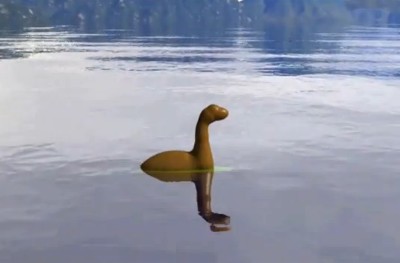 |
|
|
|
(Note:
One really has to wonder why a doctor like Wilson risked his
entire career and reputation to participate in this scheme
when there was nothing in it for him. Wilson had
nothing to gain and much to lose.)
On April 19,
1934, Duke and Ian Wetherell drove one car to Loch Ness
while Wilson and Chambers drove another.
They found a
quiet bay at the edge of the loch and put the submarine in
motion. Ian Wetherell took four photos. Despite
the small size of the model, once surrounded by water, the
men agreed the monster model looked very realistic.
Now it was time
for Robert Kenneth Wilson to offer the pictures to the Daily Mail. This was the easy part. The
Daily Mail took the bait faster than you can say 'Trojan
Horse'.
So history was
made and Wetherell got his revenge. Or did he?
Wetherell's
newest stunt backfired in a very strange way. The irony is
that the fake picture was the luckiest thing to ever happen
to the Daily Mail. The paper saw its
circulation explode and never suffered the slightest
negative consequence in the process.
Wetherell's
original plan was to expose the newspaper for its greedy
tendency to publish anything without regard for the truth.
However, to the astonishment of the five conspirators, the fake
monster trick had worked far too well. The photo of
the monster had
become international news! Even more amazing, the
Scientific Community by and large gave its approval.
Spurling's model
had been perfect. Maybe too perfect. The idea of the moving
submarine was brilliant. The illusion of motion really helped sell the
authenticity. By mounting the fake monster on a toy
submarine, the waves created around the serpent helped
create a highly realistic photo. In the photo,
the waves suggested this monster was clearly moving through
the water. This helped dispel any suspicion of a fake
photo.
But the real
coup was getting someone respectable like Dr. Wilson to join the
plot and draw suspicion away from Duke Wetherell.
The original
plan was for Marmaduke to come forward and tell an
competing newspaper how he had pulled one over on the
Daily Mail. But Duke had not expected the
photo would be widely accepted by the public as real.
That surprise changed everything. Now the conspirators realized they would taking a real chance
were they to come clean. The pranksters were trapped
by their own success. Their trick had aroused such a
huge fuss, now they were afraid to confess.
Dr. Wilson had the
most to lose. His medical practice depended on the
respect of every professional person in London. One
slip and his reputation was ruined. Christian Spurling,
Marmaduke and Ian Wetherell weren't in the clear either.
At the least, they might be facing criminal prosecution, but
at the worst the wrath of an entire world might drop on
their heads for tricking them. If the truth came out,
would some disappointed monster lover beat them up or burn
their house down?
All five men
agreed that to expose the monster as fake now would doom
them to be regarded as the worst people on the planet.
The pranksters decided the smartest path was to keep quiet.
That explains why Marmaduke abandoned his revenge angle. He felt things had gotten too out of hand to speak up now.
Instead he wisely chose to laugh quietly to himself.
So Marmaduke remained uncharacteristically silent until his
death in the 1950's.
Dr. Wilson had gone
a separate route. As the clamor rose for the identity
of the photographer, he knew someone at the Daily
Mail would eventually leak his name. At that point, there would
be many questions.
Seeing how there
was no way he was going to dodge being identified at some
point, Wilson
took the bull by the horns and decided to step forward.
Better to speak up and play the hero than wait to be
identified. Wilson granted the Commander Rupert
Gould an interview. By
wrapping himself in the respectability of Gould's
upcoming book on the Loch Ness monster, Wilson could
establish his 'alibi' and pray that it took hold.
Although Wilson
had earlier claimed his friend was a married woman, now he
admitted it had been Maurice Chambers who was in the car
with him. Wilson figured the more truth he told, the better
his chances of coming out unscathed.
And with that,
Spurling concluded his story. He pointed out that he
didn't care what anyone thought about him. And the
other four were long gone. Duke Wetherell and Maurice Chambers died
in the mid-Fifties. R. Kenneth Wilson died in Australia in
1969. His stepbrother Ian Wetherell had died in 1986.
|
|
|
In an odd turn,
Christian Spurling himself died in November 1993. This
happened just weeks after
finishing the interviews regarding his strange tale.
With
Spurling deceased, there was no hurry. So the
researchers decided to time their scoop to the 60th
anniversary of the photograph. They
deliberately waited four months after his death before breaking the news.
Boyd and Martin released the
story of the scandal to the public on March
11, 1994.
|
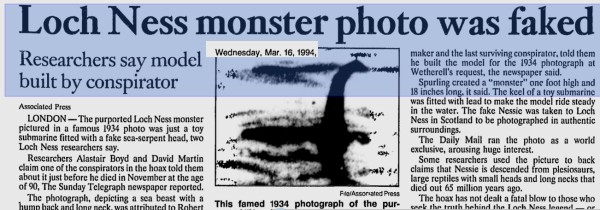 |
|
|
|
Of course, the
media immediately termed Spurling's story a "deathbed
confession", but that wasn't exactly true. After all, Boyd and
Martin had sought out Spurling, not the other way around.
However, terming
it "deathbed confession" made it seem more dramatic, so
that's how people referred to it.
Five years
later in 1999, Boyd and Martin
would go on to offer every juicy detail in a book, Nessie:
the Surgeon's Photograph Exposed.
In
case anyone is curious, Spurling said the fake model is buried at Loch
Ness. Apparently shortly after the photo shoot, Duke Wetherell
heard the water bailiff approaching. Panicked at being caught, Wetherell stuck his foot out and crushed
the fragile model. Then he mashed it into the sand beneath the
shallow waters.
So one can
assume there truly is at least one Loch Ness Monster lying
down at the bottom of Loch Ness.
(For a wonderful
2 minute National Geographic recap of this story,
click here)
|
Here We
Go Again!!
|
Rick Archer's Note: Just
when you think things can't get any weirder, it turns out
there has been a recent 2013 replay of the Surgeon's Photo
scenario. And what is especially funny is that our old
friend the Daily Mail is carrying the story. Some
things never change!
|
Cruise Boat Skipper
Admits Hoax!
|
By Lizzie Edmonds
The Daily Mail Online
5 October 2013
George Edwards' March 2012 photo was billed as some of the most convincing evidence that
the Loch Ness Monster did exist.
But now the skipper behind the image of Nessie has now confirmed
it is a fake.
George Edwards owned up to the hoax - saying he'd created
the fraud for 'a bit of fun'.
The 61-year-old simply photographed the same fake hump that
was featured in the 2011 National Geographic documentary, Truth
Behind the Loch Ness Monster.
Today Mr Edwards, who was involved in the production of the
documentary and had access to the fake hump, said he had no
regrets about the picture despite fooling people for over a
year.
The image will now join a host of other fakes, including the
now notorious image taken by Dr Robert Kenneth Wilson in
1934 showing the monster's head and long neck.
|
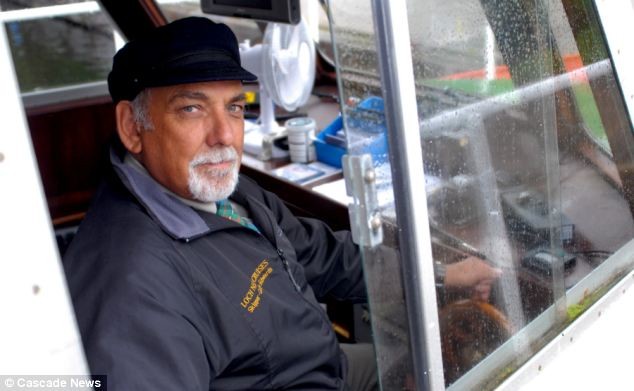
Fraud:
George Edwards, pictured in his tour boat,
says the mystery of the monster brings tourism to the area.
He does not regret publishing his fake photo. |
|
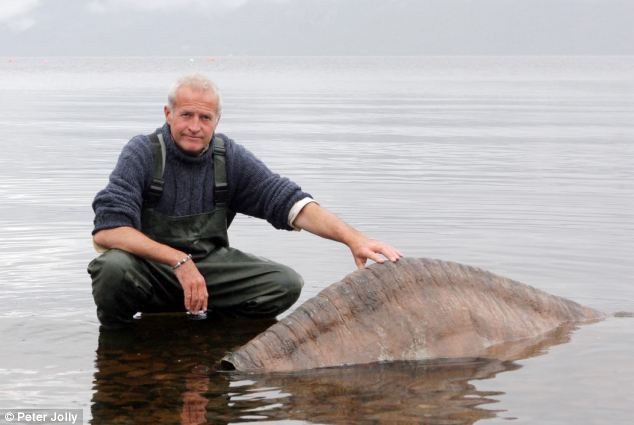
This is
Nessie expert Steve Feltham pictured beside the carbon
fiber hump
that George Edwards used to produce his image.
This 'hump' was originally used in a 2011 National
Geographic documentary
|
Mr Edwards, a cruise boat operator on Loch Ness, produced
and published the image in March of 2012.
Mr.
Edwards said:
"Why should I feel
guilty for having a bit of fun?
Where would Loch Ness be without the world’s best known
forgery, the Surgeon’s Photograph?
These so-called experts come along with their theories
about big waves and big fish, and their visitor center, but
I’m sick to death of them.
People come here for a
holiday and a bit of fun. I’m one of the people who has
brought thousands of people to the Highlands over the
years. I can tell you they don’t come here for the
science."
The skipper also added that the picture was well known as a
fake - and that he had owned up to it just days after the image
was published.
However, there is no record of Mr Edwards' confession.
Furthermore, at the time Mr Edwards released his
now-debunked picture, he was adamant it was genuine.
|
Back when Edwards was first questioned about his Monster
photo in 2012, he said at the time:
"I did
not want to mention my sighting until I was sure
that I had not photographed a log or something
inanimate in the water in the water.
I have friends
in the USA who have friends in the military. They had my photo analyzed and they have no
doubt that I photographed an animate object in
the water. I was really excited as I am sure
that some strange creatures are lurking in the
depths of Loch Ness."
Edwards told how he spent his life on the loch - around
60 hours a week - taking tourists out on his boat Nessie Hunter IV.
He has led numerous Nessie hunts
over the years.
Edwards
said the image he photographed in 2012 convinced
him that there really was a monster out there. The image
showed a mysterious dark hump moving in the water
towards Urquhart Castle in the distance.
|
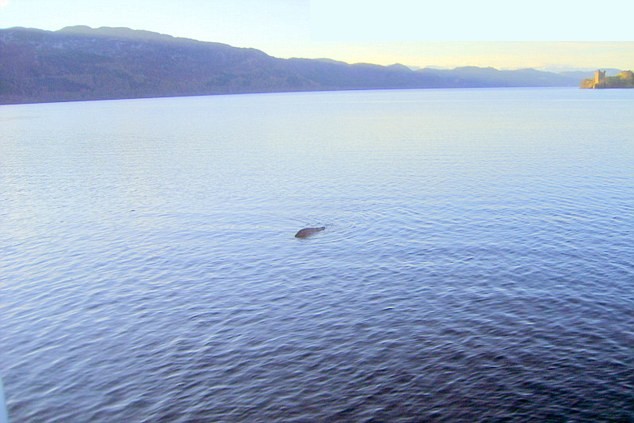
This is the picture George
Edwards published in March 2012.
He has now admitted that this picture is a fake.
Edwards said he did it for "the fun of it".
|
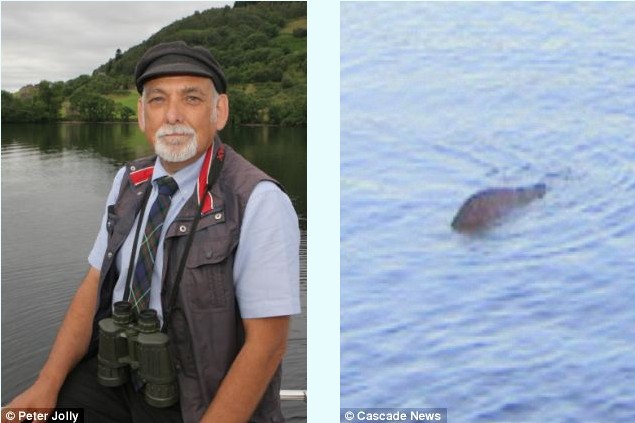
At the
time Mr Edwards first released his picture, he was adamant
it was genuine. 'Unequivocal': Edwards said he had the
picture independently verified by a team of US military
monster experts as well as a Nessie sighting specialist.
He now says he released the image for 'a bit of fun'
|
Back in 2012, Edwards said this about his photograph:
"I was just about to return to
Temple Pier in Drumnadrochit and I went to the back
of the boat which was facing the pier and that’s
when I saw it.
It was slowly moving up the loch towards Urquhart
Castle and it was a dark grey colour. It was quite a
fair way from the boat, probably about half a mile
away but it’s difficult to tell in water.
I watched the
object for five to ten minutes, then it slowly sank
below the surface and never resurfaced.
I’m
convinced I was seeing Nessie as I believe in these
creatures. Far too many people have being seeing them for
far too long."
The first recorded sighting was in 565 AD and there have
been thousands of eye witness reports since then.
All these people can’t be telling lies. And the fact the
reports stretch over so many years mean there can’t just be
one of them. I’m convinced there are several monsters."
|
Meanwhile, local people are up in arms.
Steve
Feltham, a man who has dedicated the past
22 years to hunting for Nessie, was praising Edwards' photo
a year ago. Mr. Feltham was unequivocal when he said
in 2012:
'It
is the best photograph [of the monster] I think I have ever seen.'
'I think the images are fantastic - that’s the animal I have
been looking for all this time.
'I would say it doesn’t prove what Nessie is, but it does
prove what Nessie isn’t. A sturgeon is a fish that has
been put forward as one of the main explanations as to what Nessie could be.
But this hasn’t got a serrated spine like
the sturgeon.'
Yesterday, Mr Feltham said the admission harmed Mr Edwards’
credibility and the Loch Ness Monster brand. Feltham added
that the skipper is nothing more than a fake and a
fraud.
'It does the subject
[of the monster] no good and damages his own
reputation.'
'When you read things like this in the papers, people will
think it’s all just a fairytale.'
'But if you read the reports and books you’re more likely to
think that something is there to be explained. He’s supposed
to be taking people out on tours but he’s nothing more than
a faker and a liar.'
The Loch Ness area is no stranger to controversy. Over
the years, the Monster has been the subject of many
sightings in the Scottish Highlands. Out of the hundreds of supposed sightings over the
years, most have been dismissed as hoax or
fantasy.
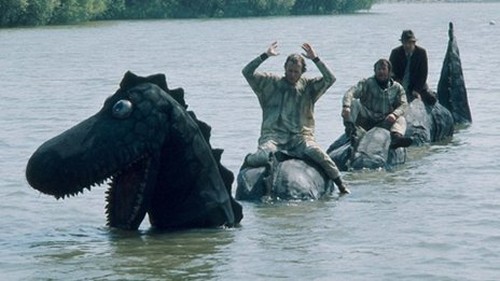 |
In the past, Mr Edwards
has criticized area's tourist community,
who he says takes a 'scientific' rather than a 'fun' approach
to Nessie.
Edwards has said the Drumnadrochit Chamber of Commerce treats the
monster as 'a myth' which damages the tourist industry.
In June, Edwards wrote an open letter to the group in which
he said:
"Most of the people I talk to on my boat know that
it’s just a bit of fun. What brings more people to Loch Ness - my little stories
about Nessie, or the so-called experts going on about big
waves and big fish? They should stop taking themselves so
seriously.
At the end of the day there’s no such thing as an expert on
Loch Ness, just people with an opinion."
|
|
The
Latest Loch Ness
'Sighting' Causes a Monstrous Fight
|
Written by Jenny Gross
The Wall Street Journal
October 4, 2013
Discredited Nessie
Photo Emerges to Shake the Faith in Drumnadrochit
DRUMNADROCHIT, Scotland—
Steve Feltham was surveying the shores of the Loch
Ness last summer when his cellphone rang, breaking his
concentration. A local reporter was calling to say she had
just received a photo of the Loch Ness Monster—its arched
hump protruding from the waters—and she wanted to run it by
him before sending it to print.
Mr. Feltham, a full-time monster hunter for 22 years,
studied the photo.
"It is the best photograph I think I have ever seen," he
told the journalist at the Inverness Courier from his home,
a van parked on the pebbled shores of Loch Ness.
Many in Drumnadrochit, a village in northern Scotland, and
throughout Britain, hailed the photo taken by George
Edwards, a tour guide, as one of the most convincing monster
pictures ever taken. It is the centerpiece of his tour
company which operates out of Nessieland, a Loch Ness
tourism center. He sells postcards of his photos to
passengers for 50 pence (80 cents) apiece.
But now Mr.
Feltham has retracted his backing of a photo
of Nessie, igniting a controversy.
Mr. Feltham says his endorsement was a grave error. He says he soon realized the
photo was actually of a 6-foot-long fiberglass hump used as a prop
in a documentary filmed on Mr. Edwards's boat in 2011.
Other local experts agreed. Adrian Shine,
a Nessie researcher and designer of the Loch Ness Center and
Exhibition, and Dick Raynor, another researcher, say the photo is so
obviously fake that it's an insult to visitors.
Mr. Edwards's photo has become the centerpiece
of a fierce debate ripping through Drumnadrochit.
It has exposed a
bitter truth: Some key players in the Nessie industry don't believe
the Loch Ness Monster exists.
|
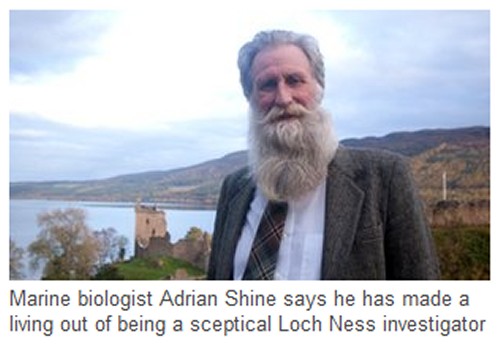 |
One Monday afternoon recently, Mr.
Edwards lashed out at his critics to passengers on his tour
boat.
Nothing irritates him more than the
fact that some of his customers have just walked over from
the Loch Ness Center and Exhibition
where they are told the monster may not be real
(the Center sits 300 yards
from Nessieland). They are
so depressed that these people are ready to go to home.
Incredulous, Mr. Edwards in May escalated his complaint with
the town's fathers.
"I carry thousands of tourists
on Nessie Hunter every year and I am concerned when
passengers tell me that after they have visited the
self-proclaimed Official Loch Ness Exhibition and Center
they come out feeling disappointed after [being] told
that Nessie is a myth or a figment of the imagination."
Mr. Edwards wrote in a letter to
the Drumnadrochit Chamber of Commerce.
"In recent years we have seen a
decline in tourism across Scotland and maybe it is time
for Adrian Shine to put up or shut up."
Tony Harmsworth is
the author of the book
Loch Ness
Monster, Nessie & Me.
He is also a
tour guide and the editor of the
chamber's website. In a written
response to Edwards' comments, Harmsworth
accused Mr. Edwards of treating tourists like gullible fools
and sending them away with "their heads full of garbage.
Edwards should not have to
resort to 'fakery' to keep his customers entertained".
Says Mr. Shine: "I would concur
with that. That is exactly what he [Mr. Edwards] does and
what he now admits of doing. He says people like
it this way."
Not everyone
agreed with Harmsworth or Shine. The Chamber of Commerce demanded
Mr. Harmsworth remove his rebuttal to Mr. Edwards from the
website, along with any other critical comments about Mr.
Edwards.
Disgusted members of
the Chamber of Commerce as well as the Loch Ness Center and
Exhibition resigned in protest. Robert Cockburn, the
Chamber chairman, says the group is officially neutral on Nessie's existence, and he is ambivalent on the Loch Ness
Center's resignations.
Angered that
fellow members
failed to back him,
Mr Harmsworth subsequently also resigned from the Drumnadrochit
Chamber of Commerce.
Mr. Harmsworth argues that monsters
cannot possibly live in Loch Ness. "Can anyone trust what
the chamber is doing anymore?" he said. "To just feed people
fake pictures because that's what you think they want is not
really the way forward for tourism in the Highlands of
Scotland."
|
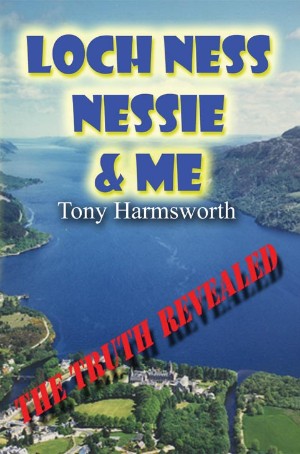 |
| |
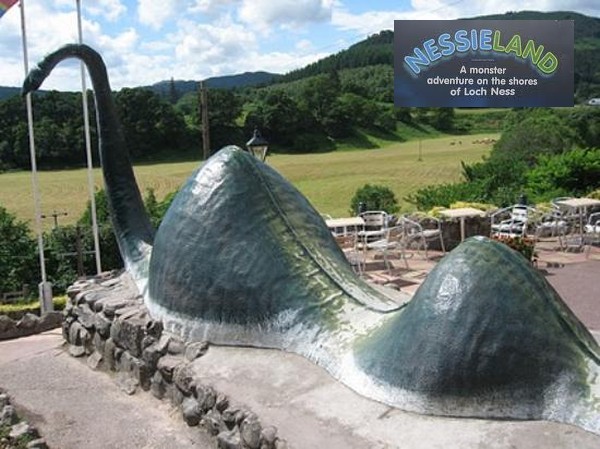 |
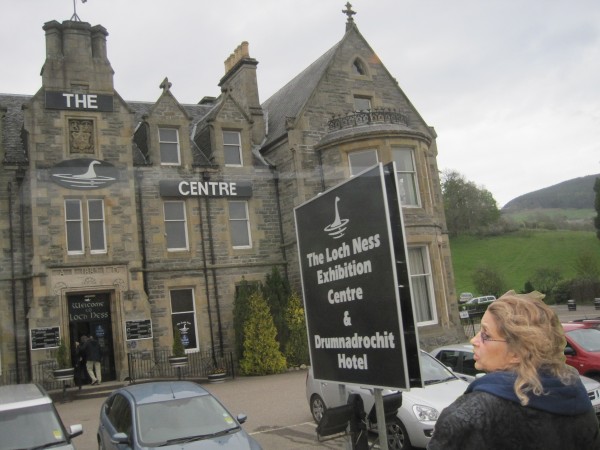 |
Obviously Edward's fake photograph has exposed a rift in the
Loch Ness community as deep as the Great Glen itself. Some
support the 'commercial approach' while others prefer to
stick to science.
A major
battle front is the competing tourist centers, Nessieland
and the Loch Ness Center.
Their tours start similarly with
visitors walking through a dark, tunnel-like
entrance. But at Nessieland, tourists are regaled
with tales of monster sightings and secret passages in the
loch where Nessie may be lurking.
Contrarily, the
Loch Ness Center casts the monster as a myth. When it
talks about supposed sightings of the monster since 1933, it
plays circus music in the background.
The two tourist centers have a history of not getting along.
In June, police cautioned and charged the owner of
Nessieland, Donald Skinner, for stealing a sign outside
the Loch Ness Center. Skinner said he "took custodianship"
of the sign because it was blocking one of his own.
Mr. Shine says tourists would rather know the truth than be
misled.
But Mr. Edwards, who was laid off from his job as an oil worker
in the 1980s, disagrees. He says his critics are trying to destroy Loch
Ness, which depends heavily on tourism. "Can you imagine if
Mr. Shine or Mr. Raynor came across to America and walked
into Disneyland and told all the children there's no such
thing as Mickey Mouse? Don't be taken in by all this rubbish.
That's what they're doing here."
Mr. Edwards adds that he has no doubt that there are some
mysterious creatures in the Loch Ness, including Nessie.
But he also has a confession. Throughout the fracas over his
photo, it is true he insisted to the local media it was real. He
initially declined to comment to The Wall Street Journal.
But he has relented, recently telling a boat full of
passengers that he manufactured the shot to win attention
for Nessie and to prove how easy it is to fake photos.
However, he said another photo he took of Nessie—from
summers ago—is for real:
"I've taken photographs over the years. One in particular,
on the 6th of June, 1986, is an absolutely genuine
photograph."
|
| |
|
Hoax!
|
The George Edwards Loch Ness Photos
Debunked as a Hoax
Squatchdetective's Blog
Thoughts from Steve Kulls
February 8, 2013
"There are times when I write something with a heavy heart,
and this is one such occasion.
In February 2011, I [Steve Kulls]
was the team leader for the National
Geographic special, The Truth
Behind the Loch Ness Monster.
The skipper for
the boat we used, The Nessie Hunter, was George Edwards.
Edwards was
a life long tour boat guide on the Loch who claimed to have
two sightings of the famed Nessie.
In March 2012 George released what was purported to be the
best picture of Nessie yet.
Tonight
(February 8, 2013) while doing a radio show, someone
asked if I had seen the photos of George Edwards. I did not,
but then I was suddenly surprised as I remembered our
weathered Scottish captain.
When I saw the pictures, my heart sank as I recognized it
immediately.
That picture of
Nessie was almost certainly the same prop we had used in our
documentary. I was sure of it.
I began to think
back. I remember George on the top deck of the
boat, taking pictures of our prop hump,
the one we used in sighting recreations for the
program. The hump itself, was not made by the crew but had
previously been used for another program.
Yes, they are certainly the same.
Sorry George, I now believe you are
a hoaxer, and I say this with a heavy heart.
But it is what it is.
I also remember being suspicious
of George. When our 3 day boat
expedition had come to an end,
it was time for the polygraph tests of some of the
eyewitnesses. These tests were
administered by the super examiner and Scotland Yard
retiree, David Byrd, who was
phenomenal.
Both Mikko Takala and the nice lady from the Highlands
passed the test with flying colors. Then it came time for
George’s turn. He looked nervous
as hell. Edwards failed the test.
Due to George running a local tourist business, a decision
was made by the production team to cut that from the final
copy of the show, as did the hydrophone testing run by the
Marine Biologists brought in.
Although I say this with a heavy heart, I am so proud
of polygraph
operator David Byrd
who was right on the money.
It seems that the two people
involved in the show who turned
out to be hoaxers,
their main motive was money.
First Preston, trying to
sell his photograph to anyone who wanted to put it in a
commercial application and now Edwards trying to boost his
tour boat business.
Well, yet another hoax busted and another hoaxer revealed.
But its all part of the job." --
Steve Kulls
|
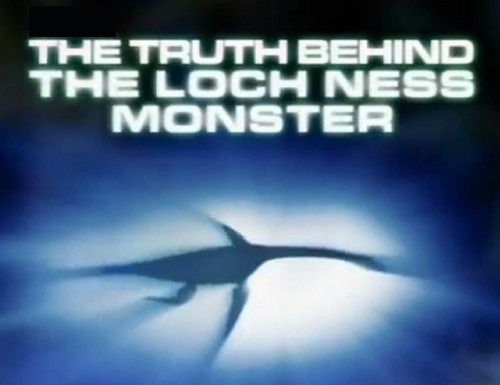
2011 National
Geographic special:
The Truth
Behind the Loch Ness Monster
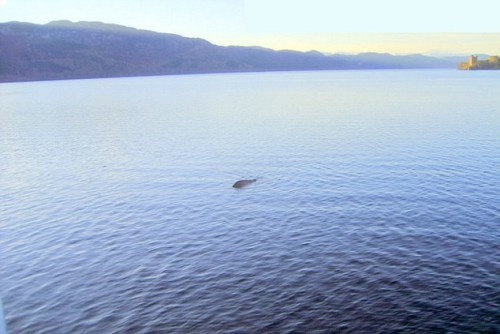
The newest
fake photo of Nessie, March 2012
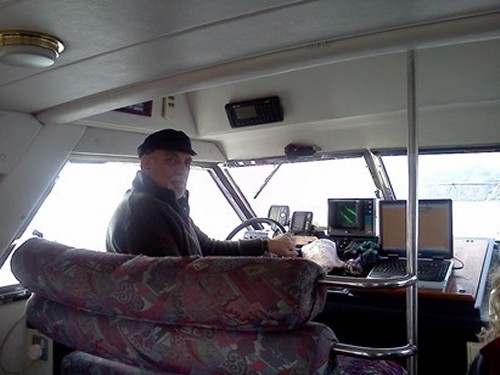
George
Edwards |
The Wish to have a Monster
|
|
|
|
Rick
Archer's Note: I hope you have enjoyed this story
of the Loch Ness Monster. I am sure you will agree it is a
tale that reveals a great deal about human nature.
It seems over the course of this story, people tend to get more
honest when they have less to gain and more dishonest when
they have more to gain. Time and again, we see the story
of this Monster has brought out both the best and the worst
in people.
At its very core,
this story has been about truth, honesty, lies and
deception.
While
researching, I became increasingly aware that there is still
a great deal of debate on all sorts of things. Of
course there is the neverending back and forth over the
existence of the Monster, but I was surprised to see there
is a very serious debate over the truth of the 1994 "Spurling's Confession".
|
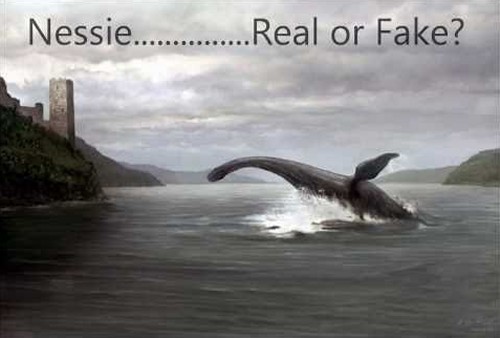 |
|
|
Starting in
1934, for sixty years the debate centered around the
validity of the Surgeon's Photo. Then starting in
1994, the past
twenty years has seen the debate include the validity of the
1994 Spurling Confession.
I was very surprised to discover some
people don't believe "Spurling's Death Bed
Confession" about Marmaduke's lust for revenge using the toy monster model.
For that matter, I found articles from certain writers
who still believe Colonel Wilson's Surgeon's Photo
is legitimate.
I could not
understand why these people were arguing so fiercely until
this information caught my eye:
"Tourism is said
to have generated an estimated $37 million to the Highlands in 1993, but then
came the crippling Christian Spurling deathbed confession.
The debunking of the Surgeon's Photo drove a serious stake
deep into the heart of the Nessie faithful across the
planet.
Unfortunately,
business has slowed down in recent years. In 2007, it was
estimated that Nessie tourism brought in an estimated £6
million ($12.2 million), less than a third compared to the
year that preceded the confession."
I had no idea
how devastating the 1994 news of Spurling's Confession had been
to the area's economy. Then it dawned on me - the Loch Ness
economy does much better when most people believe the
monster exists. Many yearn for the days to return when
the Surgeon's Photo ruled the earth. And the only way
that will ever happen is to discredit Spurling's Confession.
The leading
'Spurling Confession' critic is a man named Henry Bauer. Dr. Bauer is an emeritus
professor of chemistry and science studies at Virginia Tech.
Dr. Bauer has
created an
incredible
27 page Powerpoint on the Internet to prove that
Christian Spurling was lying on his deathbed and that this whole elaborate story about the balsa wood
model and Marmaduke's revenge motive is complete nonsense.
I took a brief stroll
through all 27 pages. I can certainly attest that Dr.
Bauer went to a lot of trouble. I was impressed with
how thorough he was.
That said, I
don't agree with Dr. Bauer. I have a hard time believing
that a 90-year old man in failing health is going to make up
a story as intricate as Mastermind Marmaduke's revenge
story. Mind you, Spurling's wife is listening in. Mind
you, two investigators were taping his every word.
Furthermore, the
story is plausible with plenty of details. If
Marmaduke is crazy enough to try one hoax - the stupid hippo
foot - why would it surprise anyone to think Marmaduke
wouldn't try another trick after he has been disgraced?
My point is
simple. Proving or discrediting the existence of the
Loch Ness Monster absolutely dominates the lives of some
people. Rising to the level of obsession, some people
will stop at nothing to prove they are right.
The famous Surgeon's
Photo was taken on 19 April, 1934.
It
triggered a public passion for “Nessie” that
lives on to this day. In 2014, we marked the
80th Anniversary of that iconic picture. What is remarkable is that
80 years later without a
single
definitive SIGHTING, there are still people who devote their
lives to searching for the monster.
Cary Cooper, professor
of psychology and health at Lancaster University, explained
why he thought Nessie had captured people’s imagination for so
many years.
“In general,
people’s lives are incredibly mundane and predictable, and from
that a desire to find something “inexplicable” – monsters,
spaceships or aliens, runs through us. Science says Nessie
cannot exist, and even if she did they would have found her by
now, but that only seems to fuel the flames for theories.
The famous picture has been dismissed as a fake, but that has not
stopped people wanting to believe that she is real – that she
defies what the rational scientists tell us.
If you add to people’s natural leaning for a belief in the
unexplained to the slick marketing machine behind the monster,
then
you have a mystery that will never die.”
|
 |
|
|
|
People predicted Spurling's Confession would be the end of the
Loch Ness Monster, right?
Not even close. Although it may have dampened the enthusiasm a
bit, the Loch
Ness Monster industry is still thriving today.
Tourists still flock to
the Loch to have a peek. Every year there is a new
documentary such as the 2011 National Geographic investigation. Every few years there's a
new, expensive expedition that sets out to find the Truth.
Sometimes people go to
extraordinary lengths. For example, there was a 2003 BBC
special that employed satellites in outer space and 600 separate
sonar beams to try to track down the beast once and for all...
The BBC used
satellite navigation technology to aim 600 separate sonar beams
through Loch Ness to ensure that none of the loch was missed.
The research team hoped their instruments would pick up the air
in Nessie’s lungs as it reflected a distorted signal back to the
sonar sensors. The only signal they got was from their test buoy
moored several meters below the surface.
“We went from shoreline to shoreline, top to bottom on this one,
we have covered everything in this loch and we saw no signs of
any large living animal in the loch,” said Ian Florence, one of
the specialists who carried out the survey for the BBC. The
show, called Searching For The Loch Ness Monster, was
made for BBC One.
|
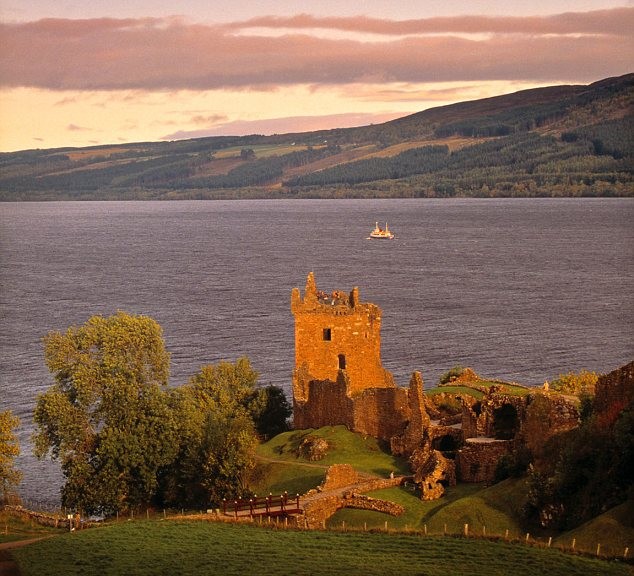 |
|
|
They found no trace of
the monster. But does anyone ever
quit? Heck, no.
The fact that there are "cryptozoologists" in the world should tell
us something. I had no idea what that word meant, so I looked
it up.
A
"cryptozoologist"
is a person who specializes in tracking legendary creatures to prove
they're real, i.e.
the type of person who spends a lot of time looking for Bigfoot and the Loch Ness
Monster. Indeed there are people who
have staked their reputations on the creature being real and depend
on the income from books asserting such.
"My Loch Ness theory is
better than yours!"
Not just the
cryptozoologists,
but also people like the Loch Ness tour guides have staked out well-defined positions on the Monster. When
one realizes that someone's income depends on being right, then one
realizes why grown men and women go to battle every day over
the "wooden head glued to a
toy submarine" theory... and why two Loch Ness tourist traps
espousing opposite positions argue with each other on a
daily basis.
In the end, it
seems over and over throughout the course of this story, people tend to get more
honest when they have less to gain and more dishonest when
they have much to gain. Time and again, we see the story
of this Monster has brought out both the best and the worst
in people.
At its very core,
this story has been about truth, honesty, lies and
deception.
Speaking of deception,
now we come to one of the greatest deceptions in history. You
will absolutely love this story.
|
|
|
1972- The Great April Fool's Joke!!
|
|
The most amazing
April's Fool's Joke in history
revolved around the Loch Ness Monster.
This incident took place in Scotland, 1972.
John Shields was the resident education
officer at the Flamingo Park Zoo in Northern England.
Due to his position, Shields, 23, was in frequent
contact with other professional zoologists at the large
Flamingo Zoo. Due to shared interests, these young men
enjoyed hanging out together. One night over perhaps too
much ale, one of the men excitedly announced that he was
part of a team hired by Loch Ness Phenomena Bureau to prove
the existence of a monster in the loch. In his zeal to
succeed, the young man announced he had developed a new
'hormone sex bait' that was certain to lure the Loch
Ness Monster from the depths in search of a mate. (No, I
didn't make this up.)
"Hey guys, why don't you join me? We can
head up to the lake on the weekend and have an expedition!
Presumably we will be poised with
a camera and the whole lot of us will become famous."
Shields wasted no time volunteering for
the adventure. Like the others, he was ambitious and ready
to make a name for himself. However, the real lure was the
chance to hang out with his buddies on the weekend.
Meanwhile, a group of British researchers
stationed in the remote Falkland Islands had captured an
unusual bull seal about 4 years old. Located in the South
Atlantic just off the coast of Argentina, the Falklands were
8,000 miles away. Thinking this unusual specimen was
perfect for a zoo, the rare animal was shipped to the Dudley
Zoo in mid-England.
Alas, the long trek was too much for the
animal. It died within a couple weeks after arriving at the
zoo. Here the story lacks details, but it appears that when
John Shields got wind of the sad tale,
a devilish thought crossed his mind. By coincidence, April
1st would be Shield's 23rd birthday. Having been the butt
of April Fool's jokes his whole life, maybe the time had
come to turn the tables and give things an interesting
twist?
Taking note that the group's excursion
was scheduled for Friday, March 31, one
day before April Fool's Day, why not take advantage of this
creature's timely appearance? With the Loch Ness adventure
soon to take place, Shields requested the animal's corpse be
transferred to Flamingo Park Zoo 130 miles to the north.
When Shields received the strange beast, he smiled. Yes, of
course his friends knew what a normal seal looked like, but
this bull elephant seal from 8,000 miles away was so exotic
and weird-looking, maybe he could fool his friends.
First Shields shaved off the dead
animal's whiskers. Then he stuffed its cheek with stones to
distort its features. His next step was to freeze the
carcass for a week. When the time was right, Shields
removed the stones. Sure enough, the seal's features were
seriously altered. Shields noted with satisfaction that the
seal looked like nothing he had ever seen.
Shields found a good reason to avoid
accompanying his friends on their Saturday expedition.
Instead he secretly arrived early on Friday, March 31, at
Loch Ness 260 miles to the north. Knowing the eight-member
team planned to meet at the Foyers House Hotel for
breakfast, Shields promptly found a nearby cove and rented a
small dinghy. About 300 yards out in the shallow water, he
dumped the carcass overboard, then beat a hasty retreat.
For his next step, Shields phoned the
manager of the hotel to anonymously report a really strange
sighting on the beach. For good measure, Shields added he
had heard there might be some researchers staying at the
Foyers House. Would the lady mind asking the men to have a
look?
The manager dutifully passed on the
information to the men just as their meal was being served.
Someone had just called, she said, to report seeing a "large
hump" floating in the loch near the hotel.
Of course the men scoffed, but they were
also curious. Methinks they weren't skeptical enough. It
never quite sunk in that this was quite a coincidence. How
convenient that the sighting had taken place within walking
distance of the hotel!! Unable to resist, the team put down
their knives and forks and walked outside. What they saw
took their breath away. Sure enough, a large, dark object
was bobbing up and down in the waves about 300 yards
offshore.
Terence O'Brien, leader of the team,
immediately swung into action. He directed the team into
their boat and they headed out to investigate. Twenty
minutes later around 9 a.m. they returned to shore dragging
behind them a bizarre carcass that appeared to be the dead
body of the Loch Ness Monster. This was an amazing moment
for the eight men.
The actions of the men were viewed in
plain sight by several of the villagers. Within minutes,
news of the discovery reached a local reporter who promptly
passed on the information to London and the rest of the
world. Television news anchors solemnly informed their
audiences that the Loch Ness Monster had been found, but was
dead. Spurred by the sensational report, the media went
nuts trying to get more details. The problem was that Loch
Ness was 450 miles north of London, so the best the
reporters could do was get people on the phone and write
down what they said. This, of course, allowed people to
exaggerate what they saw without corroboration.
|
|
|
Local residents confirmed that something
very weird had been dragged out of the water. For
example, Robert MacKenzie, a 23-year-old Inverness
musician, claimed he had the nerve to touch the
beast. MacKenzie said, "I touched it and put my
hand in its mouth. It's real, all right. I thought
it looked half-bear and half-seal... scaly, green in
color... with a horrific head like a bear with flat
ears. I was shocked."
Over the phone, witnesses told reporters
the creature was somewhere between 12 and 18 feet in
length. Although in reality the beast was 350
pounds, it was estimated to weigh 1½ tons. Asked
what it resembled, someone recalled what the
scientist team had told him. He told the reporter
the animal was like a cross between a walrus and a
seal, but 'very different'.
|
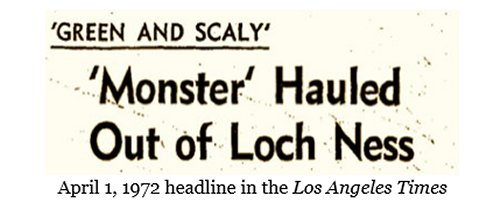 |
Next a reporter contacted Don Robinson,
Director of the Flamingo Park Zoo. Robinson was not
in on the hoax, so he was just as intrigued as
everyone else. Robinson was quoted as saying, "I've
always been skeptical about the Loch Ness Monster,
but this is definitely a monster, no doubt about
that. From the reports I've had, no one has ever
seen anything like it before... a fishy, scaly body
with a massive head and big protruding teeth."
That was exactly the quote the reporters
needed. A reputable source had just given them a
printable description of the animal. Unable to make
the long trip to Loch Ness in the far northern part
of Scotland, they had enough material to write the
story sight unseen.
The next morning, April 1... yes, April
Fool's Day... the discovery made front-page
headlines around the world. "Nessie is Found!" The
British press dubbed the creature "Son of Nessie."
The prank of John Shields had worked far beyond his
wildest imagination.
While the reporters spread the news far
and wide, there was a fascinating development back
at Loch Ness. After dragging the carcass to shore,
the scientists from the Flamingo Park Zoo sent a
telegram to their boss, Don Robinson. After
Robinson told them to bring it back to Flamingo Zoo
for inspection, the men quickly loaded the body into
their truck and took off.
Mrs. Margrete Good, manager of the hotel,
later told the press, "The zoologists were thrilled
to bits. This was a dream come true. They could
not wait to transport the monster back to the zoo
for study."
Only one problem. According to the 1933
Act of Parliament, it was illegal to remove the Loch
Ness Monster from the area. Granted it was
unlikely these scientists were familiar with this
obscure 40 year old law, but, as they say, ignorance
of the law is not an excuse.
The moment the local Inverness police
were informed the scientists had hightailed it with
the Loch Ness Monster, they were infuriated. These
were 'English' scientists, after all, who
appeared to be hell-bent on removing Scotland's most
famous lake monster. With visions of the vast,
lucrative tourist trade about to be destroyed, the
police mobilized.
The scientists had too much of a lead for
Inverness authorities to track down, but the magic
of electronics solved the problem. Immediately the
police radioed their colleagues in the Fifeshire
County police department. After explaining the
situation, the Fifeshire police were asked them to
chase down the fleeing truck and apprehend the
heinous monster-nappers.
Spurred by patriotism and outrage, the
entire police force sped off with sirens wailing,
red lights flashing. They soon caught up with the
team of alleged rogue scientists.
Out of nowhere, the scientists were
stunned to see a fleet of six police vehicles
chasing them. Intimidated by the sirens and
flashing lights, the terrified scientists swiftly
pulled over to the side of the road. From there,
the frightened zoologists were surrounded by a dozen
policemen. As one might gather, they readily
cooperated with the police. They wasted no time
opening the back of the truck to show the officers
what they were carrying.
There it was. Sure enough, according to
the subsequent police report, lying inside the truck
was a large "green and scaly" creature, quite dead.
The men turned white when one of the
officers accused them of killing the animal.
Fortunately, the scientists were able to convince
the officers that the animal had been dead for some
time, but it wasn't easy. The police officers were
absolutely convinced these men had tried to escape
with a national treasure. Unsure what to do next,
the cops radioed back to the station for advice.
They were told to take the monster to the nearest
town, Dunfermline, where it could be examined by
Scottish scientists.
|
| |
|
Searching for a
Scottish scientist to examine the creature,
they were able to persuade Michael Rushton, general
curator of the Edinburgh Zoo, to come
take a look. With
Edinburgh only 15 miles away, it did not take
Rushton long to arrive. He walked slowly around the
carcass a few times, poked it twice, and then
announced his verdict.
In Rushton's opinion, this was indeed a
strange creature, but it was no lake monster.
Instead, it was a bull elephant seal, whose natural
home was the South Atlantic Ocean located vast
thousands of miles away. Furthermore, the body
showed signs of having been frozen for an extended
period of time. Very suspicious. The eight
scientists stared at each other. Why hadn't they
noticed this?
Rushton continued, "This animal is a
typical member of its species. It is about 3 to 4
years old. Since their natural habitat is in the
South Atlantic, Falkland Islands or South Georgia, I
have never known them to come near Great Britain. I
don't know how long it's been kept in a deep freeze,
but this has obviously been done by a human hand."
|
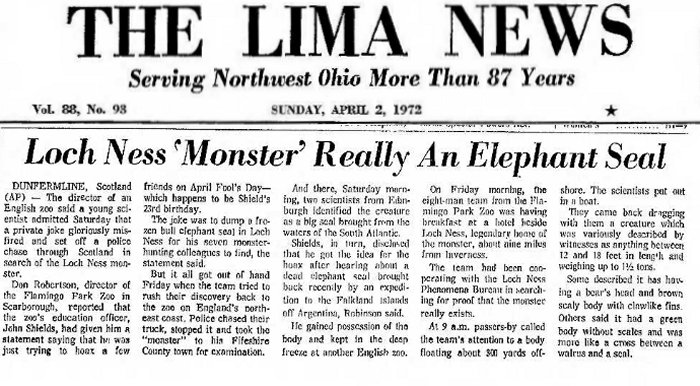 |
| |
|
Uh oh. It was about this time the
Flamingo Park scientific team realized there was
something very fishy going on, pun intended. How
on earth did a bull elephant seal from the other end
of the earth come to be floating in Loch Ness? What
was the answer? Since they had no idea their buddy
John Shields was behind this, the men had not yet
figured out they had been set up. Instead they
phoned their boss Don Robinson back at the zoo. He
told the men to return home and he would try to get
to the bottom of it.
Just about this time, Robinson noticed
Shields walk by. When Robinson told the young man
what had happened, Shields turned white. Uh oh.
What should he do? The answer could very easily
have remained a mystery for some time, but Shields
knew he would never get away with it. Eventually
someone from Dudley Zoo would hear the story and put
two and two together. Realizing the joke had gotten
way out of hand when his colleagues were chased down
by the police, Shields wasted no time confessing to
his boss what he had done. His boss was instantly
irate, but that quick confession probably saved his
life and his job.
Now it was up to Don Robinson to phone
the authorities. In the end, on Sunday, April 2,
the anxious world got the bad news... the whole
thing was just a hoax. Furthermore, the creature
was nowhere near as impressive as initial press
reports had claimed. It was only nine feet long,
not 18 as some reports had listed, and weighed a
disappointing 350 pounds. With the parade ruined,
everyone was bummed out. Much ado about nothing.
It was left to Police Superintendent Inas
McKay of Inverness to give the press the final,
official verdict on the incident:
"It was all just an elaborate April Fool's Day
joke."
|
|
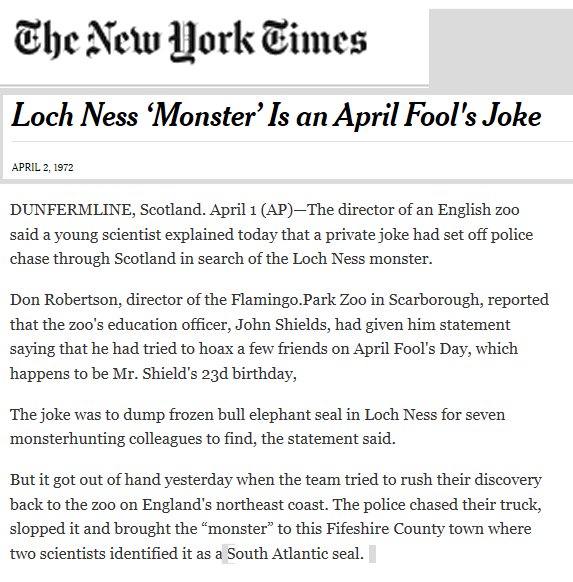 |
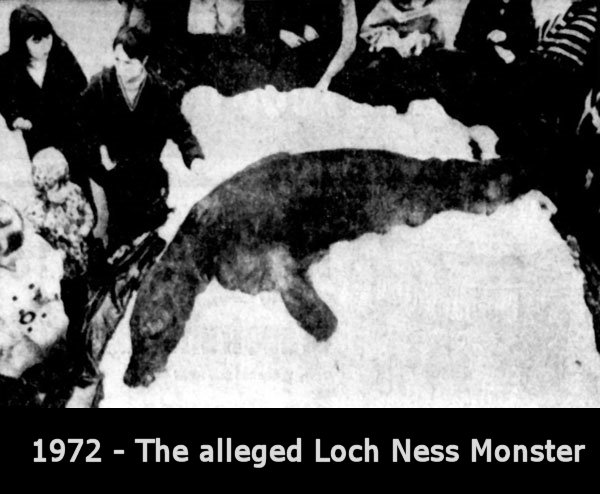 |
Epilogue to the John
Shields
Story
|
Rick
Archer's Note:
They say every
picture tells a story. Look how busy the Urquhart
Castle is. On the day I visited the Urquhart Castle,
there must have been ten different tourist buses in the
area. Indeed, the Loch Ness Monster is the best thing
to ever happen to Scotland. Research shows that in
2018, the Loch Ness Monster is worth $54 million dollars
per year to the Scottish economy.
So whatever
happened to John Shields?
After extensive
research, I was unable to find any suggestion that Shields
was punished for his outlandish stunt. I think
everyone took it for what it was: an extremely clever stunt
that went a little awry.
And why did it
go awry? Because it was so Brilliant everyone bought
the scam hook, line, and sinker!! I could not
stop laughing at the thought the cops were so convinced
the English scientists were stealing their beloved monster.
Although I am
sure his boss and friends wanted to murder him, I think deep down
they appreciated their friend's genius.
If anything, I say
John Shields deserves a medal. By drawing renewed
international attention to the Monster story, no doubt he
brought countless new tourists to the Loch Ness shores.
Beyond a doubt,
John Shields pulled off the greatest April Fool's joke of
all time.
|
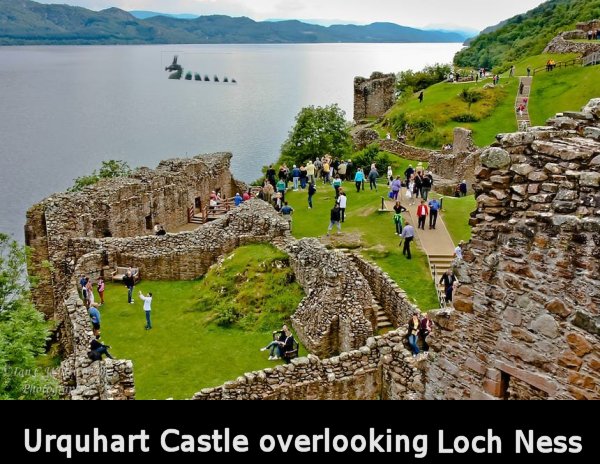 |
The Truth is
Out There... Somewhere
|
Researcher
Alastair Boyd Still Believes in Loch Ness Monster
3/13/94 (source)
|
|
|
LONDON (Reuter) -
Researcher Alastair Boyd,
the man who helped expose
the most famous Loch Ness monster picture as a fraud, still
believes in the creature, Britain's Today newspaper reported
Monday.
It quoted Boyd as saying he was convinced he saw Nessie, as
the monster of popular legend is known, in the Scottish loch in
1979.
"I saw it roll around in the water like a whale. It must
have been at least 20 feet long.
That is why I'm skeptical of people who claim to have taken
photos.
When you see it, you don't have time to fiddle with a
camera. You
are too busy picking your jaw off the ground.
I understand
that it is ironic
given my involvement in the Spurling case, but I still believe there are creatures
down in
the loch.''
|
 |
Rick
Archer's Note:
So what do I believe
about the Loch Ness Monster?
Actually I am a little surprised at myself, but after researching
this story carefully, like Alastair Boyd, I believe there is
probably something to the legend.
The first time I studied
this story back in 2010, I came away completely convinced this story was
the domain of hoaxers and con men. But the second time I went much
deeper. I spent time reading some of the testimony of the
27 people who claimed to witness the creature back in 1933. I came away
believing these people were sincere. They saw something. They
don't know what it is they saw and they had no proof, but they saw something.
Although I have a
healthy streak of skepticism in me, I am not cynical. I
believe most people tell the truth, especially when it comes to
issues where they have nothing to gain.
|
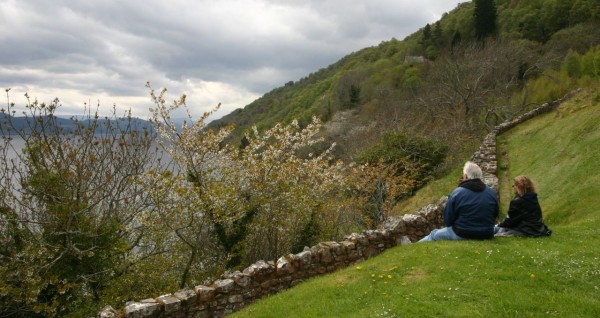
Like
everyone else, Marla and I took our shot at watching the lake
|
|
|
|
|
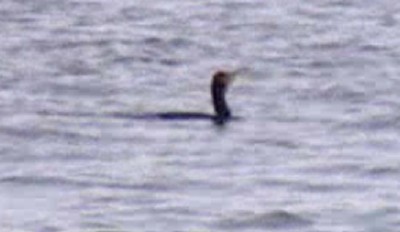 |
Some people are
crooks. The stories about Marmaduke, Colonel Wilson,
and others make that obvious. That said, in my heart, I believe
most of the Monster Sighters are people who were telling the truth.
Now it could be that they mistook a duck swimming in the distance for
a monster.
Or it could very
well be that whatever they saw 27 times in one year back in 1933 may be long gone
by now.
|
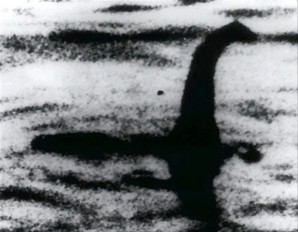 |
|
|
|
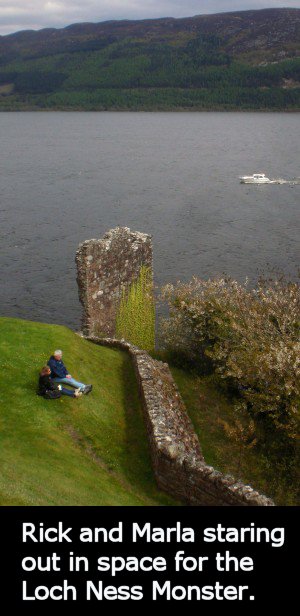 |
But that is no
reason to dismiss the heart-felt testimony of a thousand witnesses
over the past 80 years.
They saw something. That's good enough for me. In closing, I would like
to point out that Alistair Boyd, one of the two men who responsible
for obtaining
Christian Spurling's Deathbed Confession, is still a believer
himself. By exposing the hoaxes,
Boyd says he has merely discarded a single piece of
supposed evidence of dubious origins.
Boyd says this does not rule out the remainder of the evidence amassed from
eyewitness accounts.
| |
|
|
Boyd has categorically stated that in spite of the
hoax he helped unveil, he is still an
ardent believer in the creature's existence. Why?
Because Boyd says he has personally seen the beast at close quarters. Boyd
had his own sighting of the creature on July 30, 1979, as he
related in the 1999 documentary, "The Beast of Loch
Ness".
Seeing is believing. To emphasize his
point, Alastair Boyd spent three weeks in 1996 observing the Loch.
Although he himself was not fortunate enough to obtain a sighting at
that time,
16 other people staying at the Craigdarroch Hotel did, much to their
delight.
|
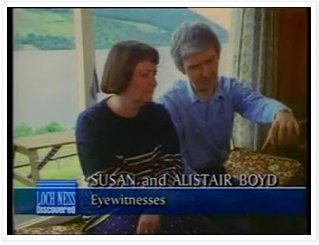 |
| |
|
|
On the other
hand, since I first wrote my article in 2011, Alistair Boyd
has dropped out sight. During my 2019 update I was
unable to locate his Internet story where 16 people staying
at the Craigdarroch Hotel became eyewitnesses. Very
disappointing.
Will we ever get
to the bottom of the Loch Ness Monster story? Probably
not, but it sure is a lot of fun to hope the legend someday
proves to be true.
Rick Archer
April
Fool's Day, 2019
(PS - Everything
I have written is as close to the truth as I could get.)
|
|